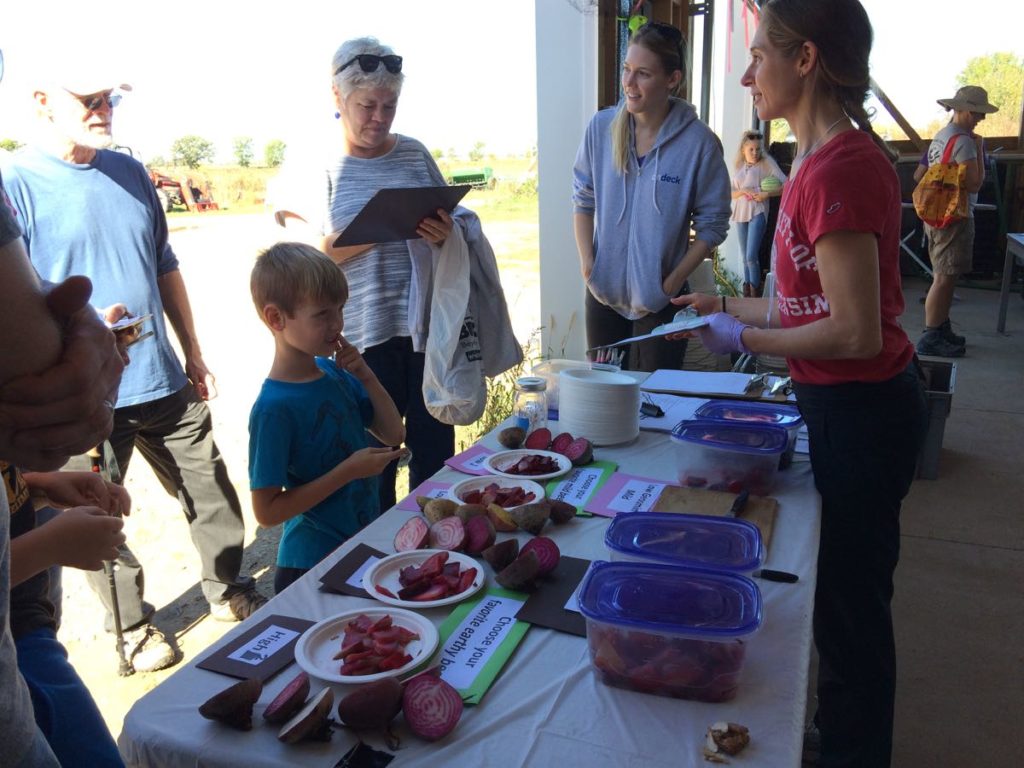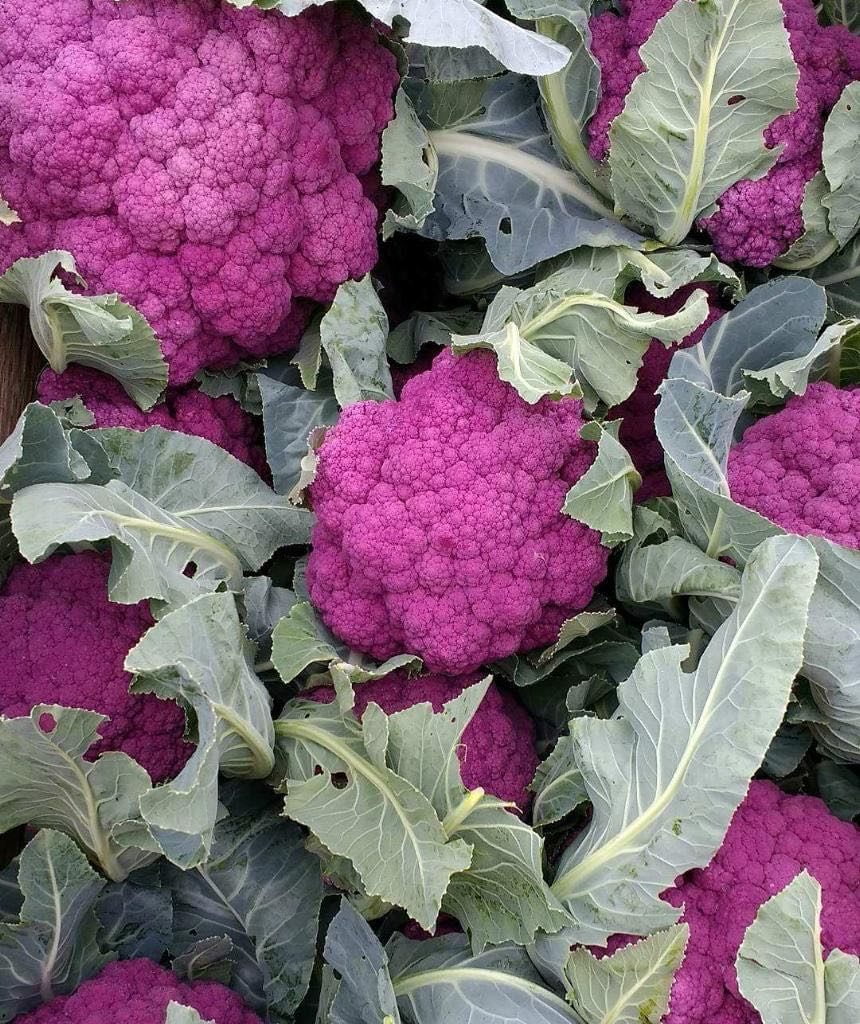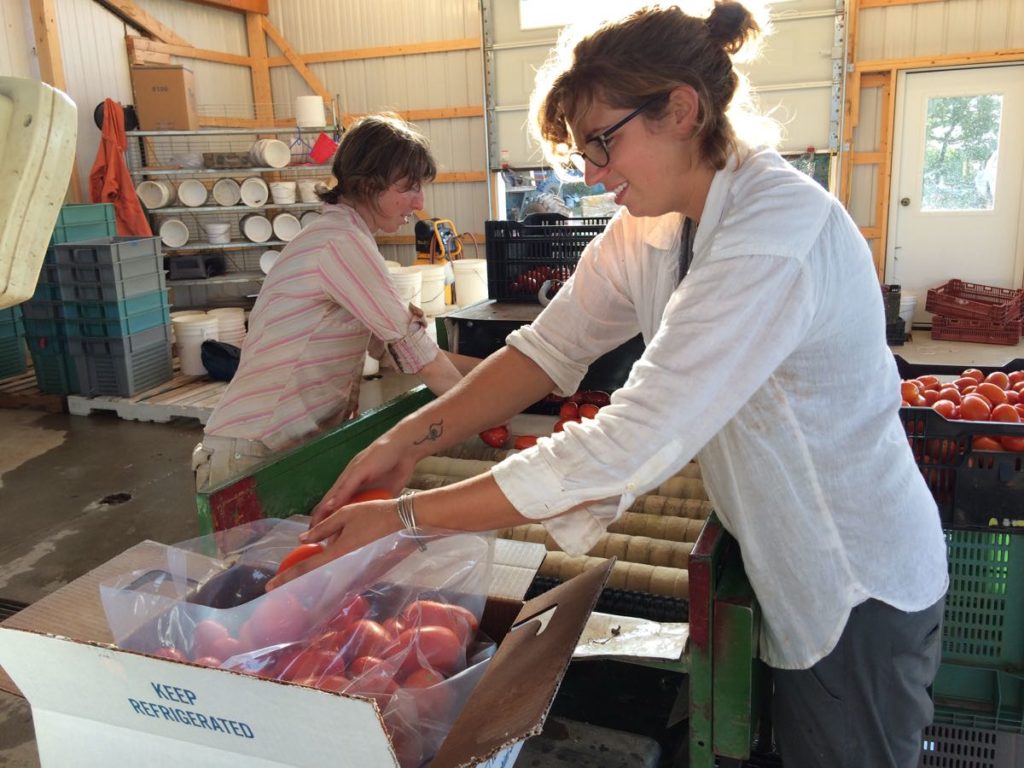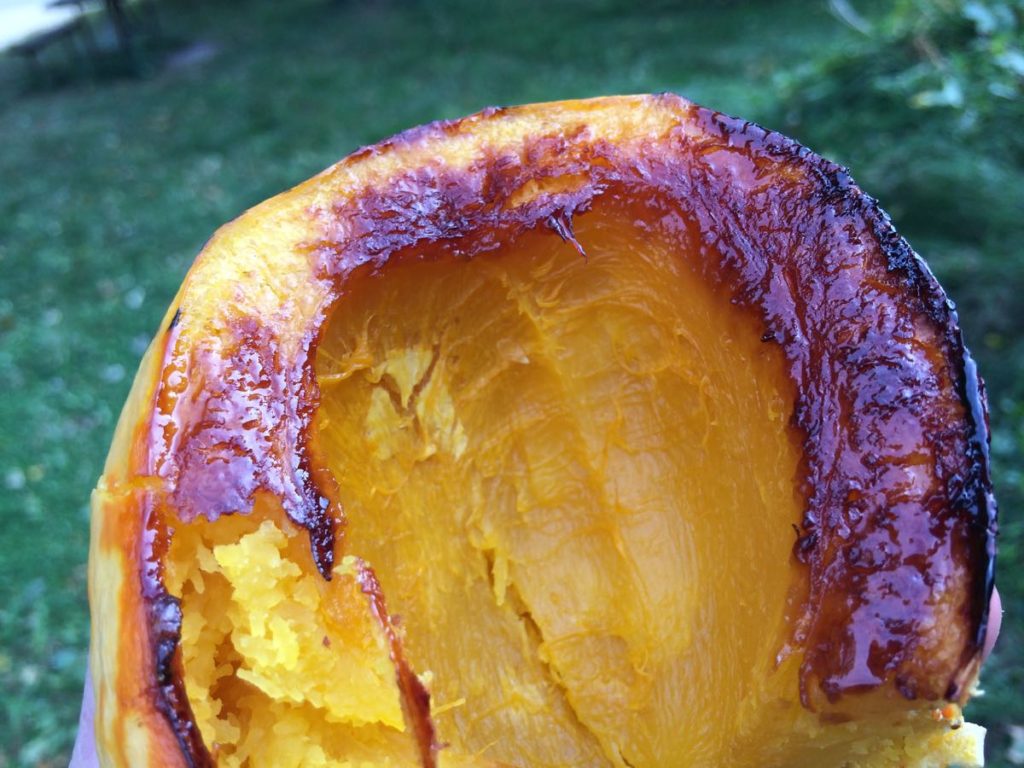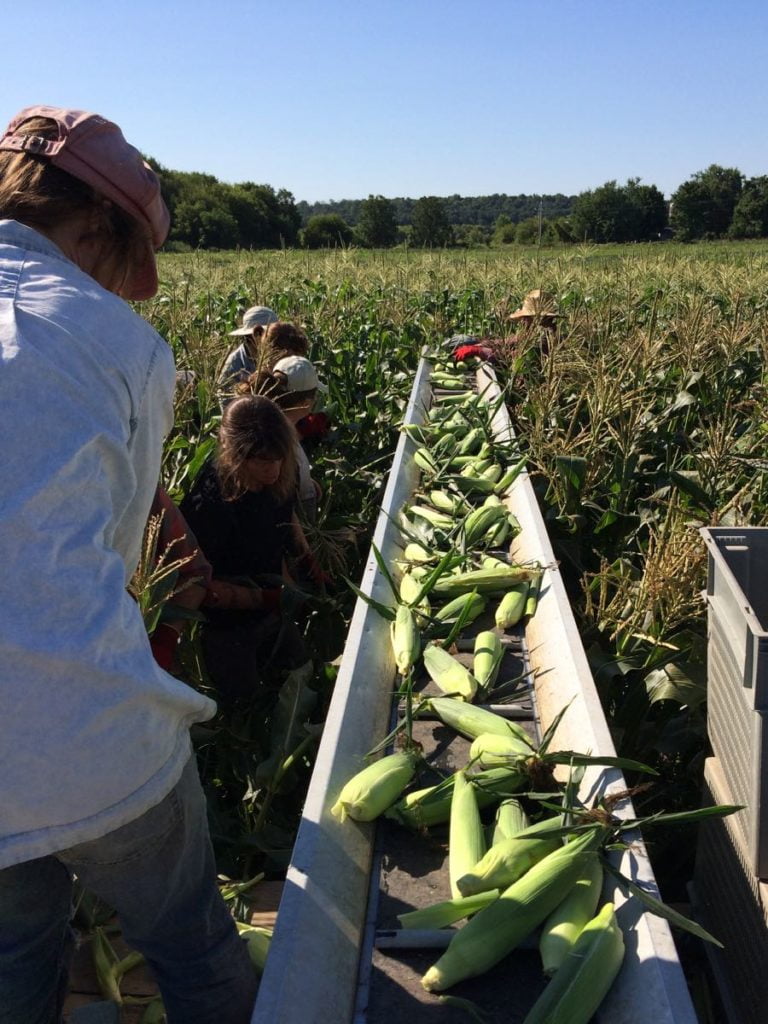Blog
Week #22, Oct 12 2017
- On: October 11, 2017
 1
1
Box Countdown
October 19/20 (next week) = final box for purple EOW members
October 26/27 = final box for weekly members & for green EOW
Extension & Storage Shares in November – Just for members registered for these extra shares. You know who you are.
Extension & Storage Share registration
We continue to get questions about these shares, which we are happy to answer. I’ve left registration open through this Sunday Oct. 15. After that, we need to move on and close the registration. Learn more here. To sign up, go here and follow instructions.
Gleaning Party
The gleaning party was wonderful. We love having all of you come visit. It’s a chance for you to experience the farm firsthand by getting in the fields, gathering produce and stomping through mud puddles. There were so many excited kids. We were very, very lucky – the weather was sunny and warm. Here’s our favorite paraphrased quote of the day: “Your CSA boxes are like the Tardis. I can’t believe how much produce you pack in there. That box is bigger on the inside than the outside.”
Here are a few photos. I got distracted during the upick and neglected to take photos. If you have good ones to share, post them to our Facebook page or send them to me and I’ll post them. I love all the kid + veggie photos. Beth
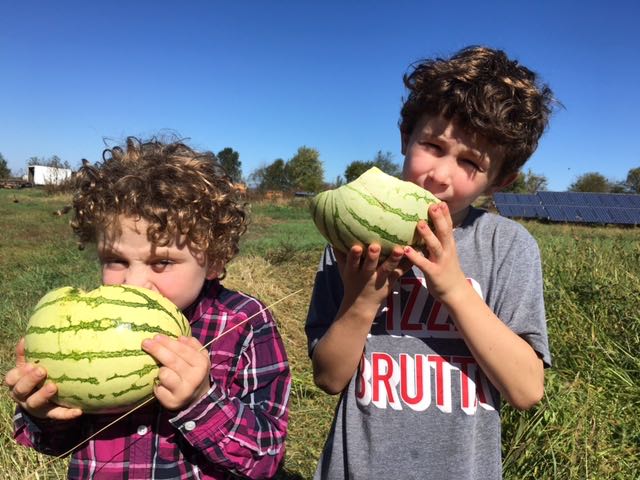
There were late-maturing melons to test how well you judge watermelon ripeness. Photo credit Shelly D

Karen and Chance silk-screened a gazillion t-shirts.

Freshly printed t-shirts in immediate use.
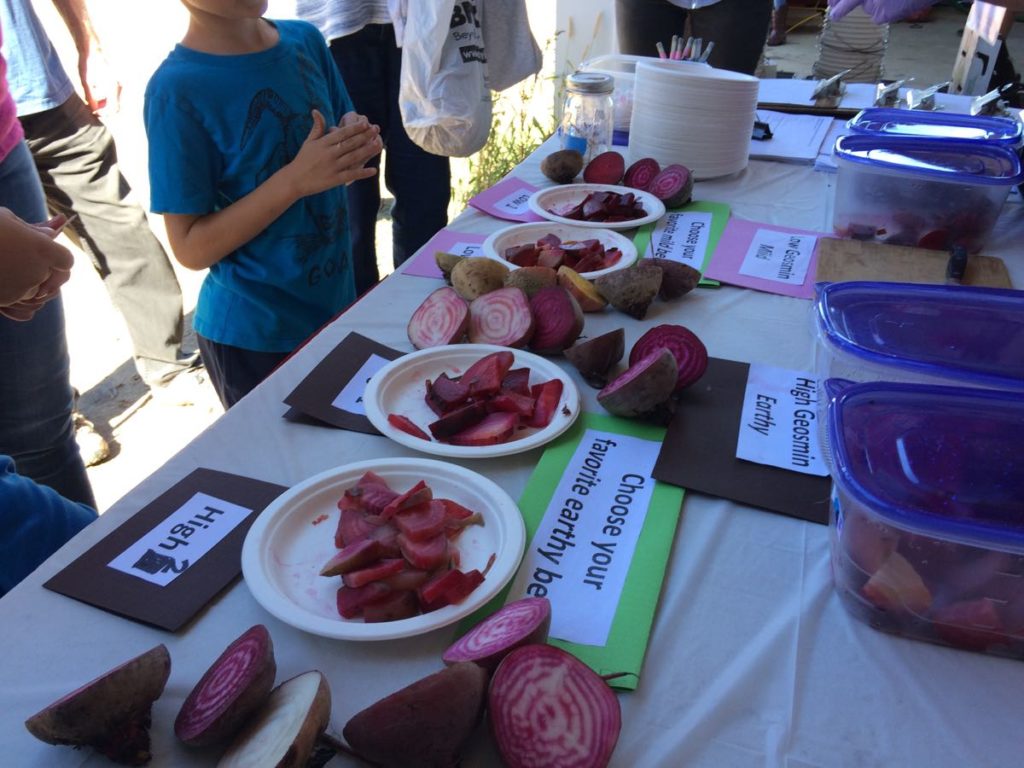
UW grad student Solveig Hanson (at right) is breeding beets for different flavor components. She offered beets for tasting, and collected members’ opinions about the flavor and appearance of her breeding lines. I explained to Solveig that you folks are not a typical population. You are a self-selected group of vegetable enthusiasts. We have helped raise Solveig’s beets for the last two years. She values having her selections grown within a genuine farm setting. After last season, Solveig decided to enroll in our CSA, giving us 100% participation of UW beet-breeding grad students. Solveig asked me to thank all of you who participated in the tasting and survey at the upick.
Veggie List and Veggie Notes (Oct. 5/6, 2017, week #22, green EOW)
Winter squash, 1 or 2
Parsnips, 1.5 lb
Carrots, 2 lb
(together in one bag)
Red bor kale, 1 bunch
Purple cauliflower
Bell peppers, ~2
Romano beans, 0.9 lb
Kohlrabi
Yellow onions
Scallions, 1 bunch
Garlic
Next week’s box will probably contain winter squash, potatoes, Brussels sprouts, leeks, carrots, scallions and more.
Parsnips (tapered, cream colored roots) – Those long, white roots are not carrots, they are parsnips. The two vegetables are related. When cooked, parsnips are sweet and starchy. For the best flavor, brown them to caramelize the sugars. Here are a few ideas for parsnip preparation:
– Caramelize the parsnips by roasting them in a vegetable medley.
– Parsnip fries are delicious: cut like French fries, oil lightly, place on a cookie sheet and roast in a hot oven until brown and cooked through.
– Try substituting grated parsnips in a potato pancake recipe. They brown beautifully and are very tasty.
– Steve loves pan-fried parsnips with onions and garlic.
Romano beans – These big beans need braising or long-cooking. They are worth the effort – lots of flavor. These are the last beans of the season. Steve is having trouble letting them go.
Winter squash – Everyone gets one or two squash, depending on size. This week’s squash are Festival (speckled acorn), Carnival (speckled acorn) or Sugar Dumpling (like a very solid sweet dumpling). Some squash have dry flaws that need trimming. I encourage you to eat these squash soon. These varieties are valuable because they are full-flavored and ready to eat soon after harvest, unlike butternuts which need time to cure. The flip side is that they do not store for long.
Purple cauliflower – Like regular cauliflower but prettier. When cooked, the color darkens but persists.
RECIPE LOG
Visit our Recipe Log, a list of all our 2017 recipes. Pat has given us a number of recipes for kale or other greens. Check out July 27, August 24, Sept. 28.
LOCAL THYME RECIPES
Comforting Classics
Lemony Cauliflower Pasta
Irish Root Vegetable and Bean Stew
Egg Salad Sandwiches with Carrot, Kohlrabi and Onion
Microwave Maple Soy Glazed Winter Squash
Outside the Box Recipes
Curry Roasted Cauliflower and Root Vegetables
Parsnip Cake with Cream Cheese Frosting
Kohlrabi Apple Salad
Squash and Caramelized Onion Pizza
Quick and Easy Meal
Kale and Pepper Eggs Benedict
RECIPES FROM LAUREN
ROASTED CAULIFLOWER & PARSNIP SOUP
There are so many fall things in this box, they just go together like a dream with minimal work. Part of me just wants to tell you to serve a huge dish of roasted cauliflower, parsnips, winter squash, onions and garlic seasoned with maple syrup and thyme with every meal you serve this week (which you can absolutely also do), but the other part of me loves to pair these same exact flavors with coconut milk and puree it into the most velvety, beautiful soup. If you have purple cauliflower, this soup will be pale purple which only makes me love it all the more. Lauren
Takes 1 hour, 15 minutes
Serves 6-8
1-1/2 pounds parsnips, peeled and cut into chunks
1 head cauliflower, cut into florets
2 garlic cloves, sliced
1/4 cup olive oil
2 teaspoons salt, divided
3/4 teaspoon freshly ground black pepper, divided
2 tablespoon butter
1/2 yellow onion, peeled and diced
1 large winter squash, peeled, seeded and diced
2 tablespoons maple syrup
1 teaspoon dried thyme
1/4 teaspoon red pepper flakes
9 cups water
15-ounce can full-fat coconut milk
- Preheat oven to 425 degrees.
- Combine parsnips, cauliflower and garlic with olive oil, 1 teaspoon salt and 1/2 teaspoon pepper on two large baking sheets. There’s a chance it would all fit on one sheet, but the veggies will just steam instead of getting all that delicious carmelization that comes from roasting. It’s worth the one extra pan to wash. I promise. Roast for 40 minutes, tossing veggies halfway through.
- In a large stock pot, melt butter. Add onion plus remaining salt and pepper. Saute for 5 minutes until onions are softened and fragrant. Add roasted veggies, diced squash, maple syrup, time and red pepper flakes. Stir and saute for a couple minutes to allow flavors to combine.
- Add water and coconut milk. Bring to a boil, reduce to a simmer and cook for 25 minutes until the squash is tender.
- Puree with an immersion blender (or blender or in your food processor in batches) until smooth. Taste and adjust seasonings as desired.
- Serve warm on a cold day.
.
ROMANO BEAN & CARROT FRIED RICE
I have fallen in love with fried rice this summer. It is the perfect vehicle for almost any summer veggies and quick to whip up with a bit of advanced planning. I love to make a huge batch of rice on Sundays and store it in my fridge until a weeknight where I’m not feeling creative. Cooking the rice ahead saves on time and also helps with the texture of the fried rice, allowing it to crisp up a bit more (if that sort of thing matters to you).
Also note that step 3 is completely optional. If you don’t care about crispy rice, you can just toss the already cooked rice (warmed in the microwave) with the veggies along with the salt and sesame oil it would have been cooked with. Lauren
Takes 1 hour
Serves 6-8
3 tablespoons butter, divided
.9 pound romano beans, thinly sliced
1 teaspoon Kosher salt, divided
2 garlic cloves, minced
1-2 tablespoons soy sauce, divided
1/2 cup water
2 carrots, diced
1 colored pepper, diced
1 tablespoon + 1 teaspoon oyster sauce, divided
6 cups cooked white rice
3 tablespoons toasted sesame oil
1 bunch scallions (white and pale green parts only, reserve dark green tops for another use), sliced
6-8 eggs
Sriracha, for serving
- Melt 2 tablespoons butter in a large saute pan over medium heat. (If you don’t have a 7+ quart saute pan, it won’t be big enough and use a stock pot or Dutch oven instead). Add romano beans along with 1/2 teaspoon of salt. Saute for 10 minutes until very tender. Add garlic, 1 teaspoon soy sauce and water to pan. Let simmer for 15 minutes until the liquid has evaporated. While that simmers, dice your carrots and bell peppers.
- Add carrots, peppers and 1 tablespoon each soy sauce and oyster sauce. Cook over medium high heat until carrots are tender and no liquid remains, 5-10 minutes. Remove cooked veggies to a very large bowl.
- Optional step (see note above). In the same pan you used to cook the veggies, pour 2 tablespoons of sesame oil in so it coats the bottom. (If there was residue from the veggies, just whip it out with a towel quickly). Heat the oil over medium high heat until hot but not smoking. Dump in your fried rice and sprinkle with remaining 1/2 teaspoon salt. Cook on medium high heat for 6-10 minutes, stirring and scraping often so that the rice gets crispy in places but doesn’t burn to the bottom of the pan. Add 1 additional tablespoon sesame oil and 1 tablespoon of butter as you go to keep things from sticking.
- Add rice to bowl of veggies followed by sliced scallions and 1 teaspoon oyster sauce. Stir to combine well and then taste. Add 1-2 teaspoons soy sauce based on your tastes.
- Serve warm with a fried egg and hot sauce. You can also scramble your eggs and fold them into the fried rice if you prefer.
.
Week #21, Oct 5 2017
- On: October 04, 2017
 0
0
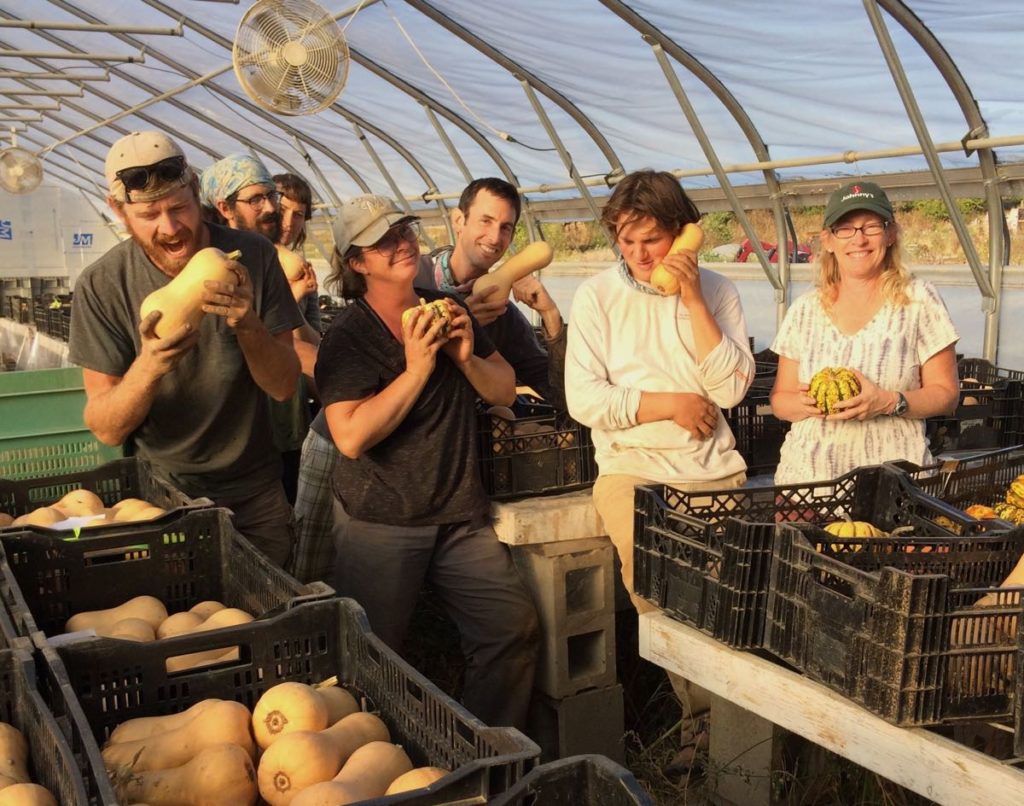
From left, Billy (ready for a snack), Smitty, Charlotte, Kristin (with a favorite squash), Jon, Jory (taking a call during our photo shoot!) and me (playing straight man). MIA Karen, Maggie & Simone.
Our winter squash crew gets a big thank you from me. Together, we clipped and picked up many, many squash over the last few weeks. It’s an exacting job to judge ripeness of the different varieties. Also, we notice that squash get heavier after you pick up a few hundred. Special thanks to Kristin, who stuck with me through every harvest this year, and to Jon and Karen who have helped with squash harvests for many years. Each crop needs judgement which makes it so valuable to work with the same crew each year. This year’s harvests happened during dry weather, perfect for us and perfect for the squash. Beth
Sweet potato harvest
Our main sweet potato harvest happened this week. (The sweet potatoes in this week’s box are from a smaller harvest a few weeks ago.) This week’s harvest was perfect. You can’t dig the sweets out of dry ground – they damage too easily. Steve irrigated the field a few days ago so the ground would be moist. Last night’s rain helped. Soil moisture was perfect and the sweet potatoes popped right out of the ground. So satisfying.
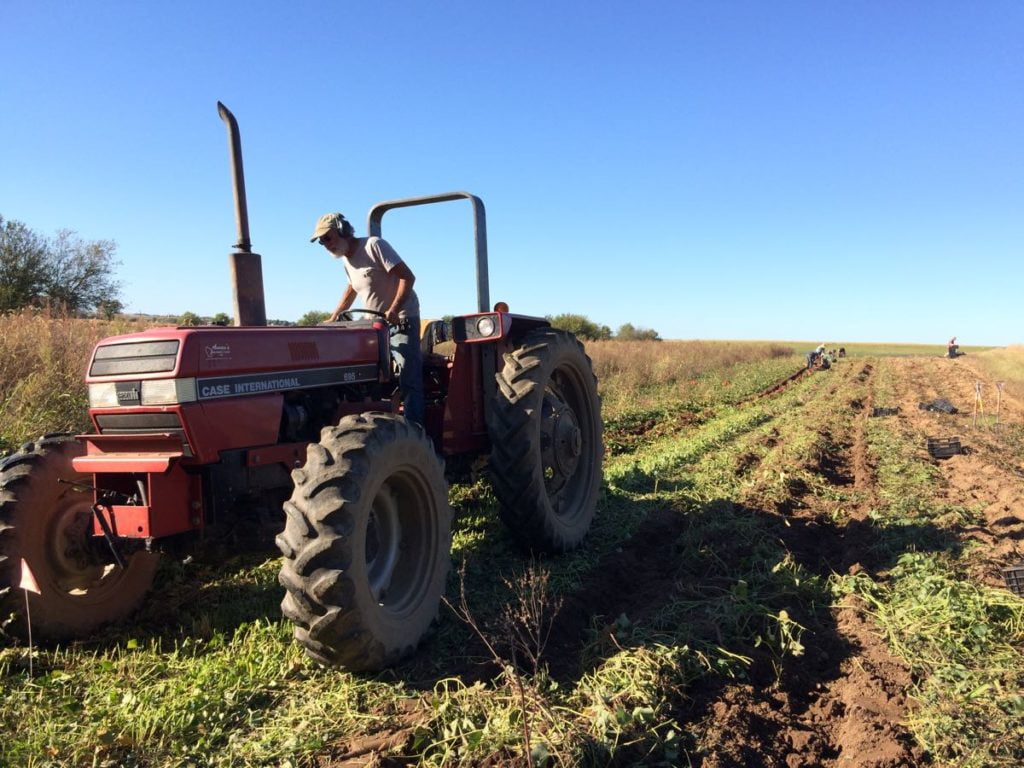
Steve undercuts the roots with the tractor and digger.
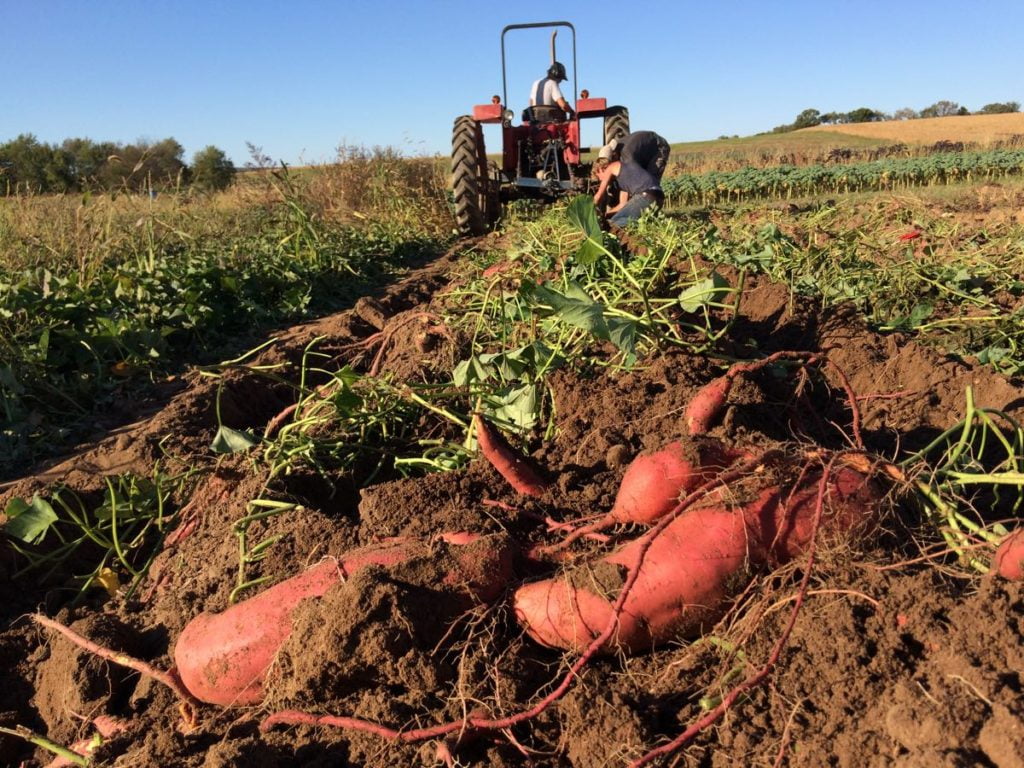
If conditions are good, the sweet potatoes end up on the surface.
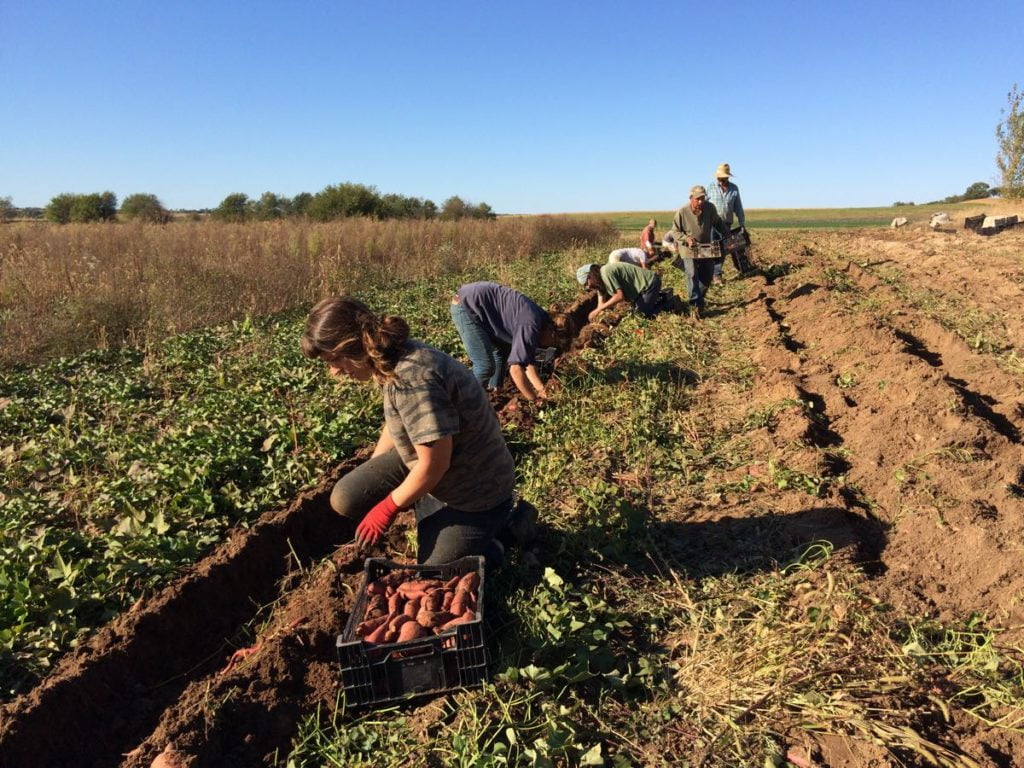
We pick them up by hand. It helps to gather a mob for this step. This crop is also heavy.
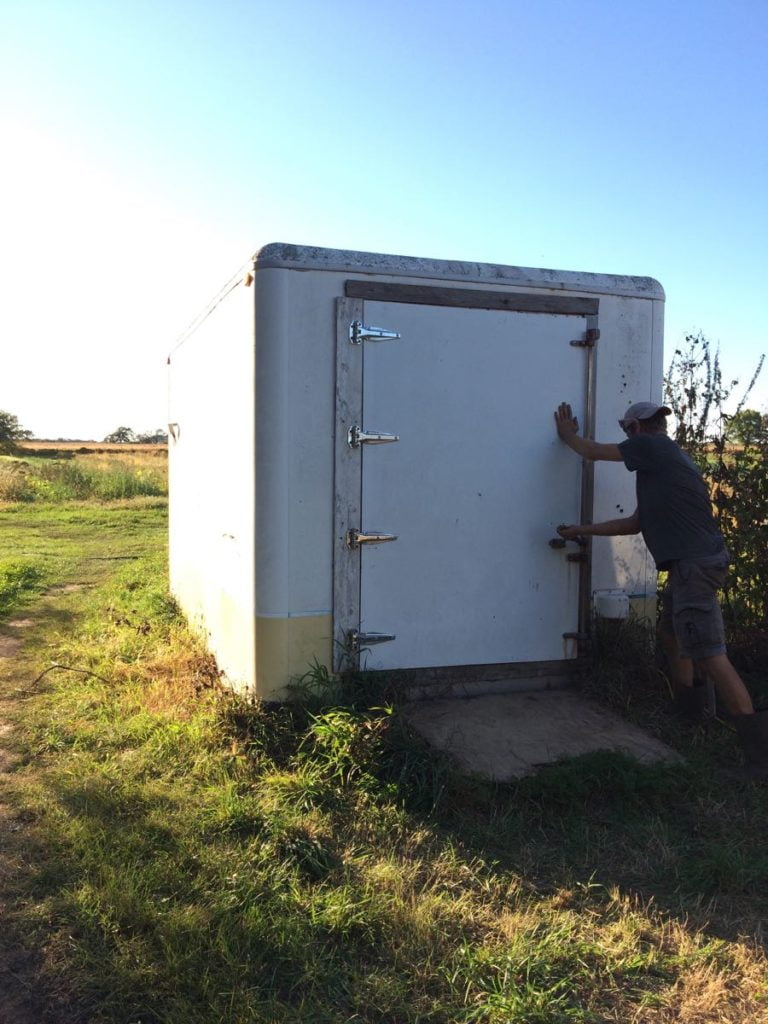
We put them in an insulated truck box and crank up the heat to 86 degrees with high humidity for a few days. That starts the curing process so the tubers sweeten and the skins toughen. Curing helps heal any dings and scrapes that happen during harvest.
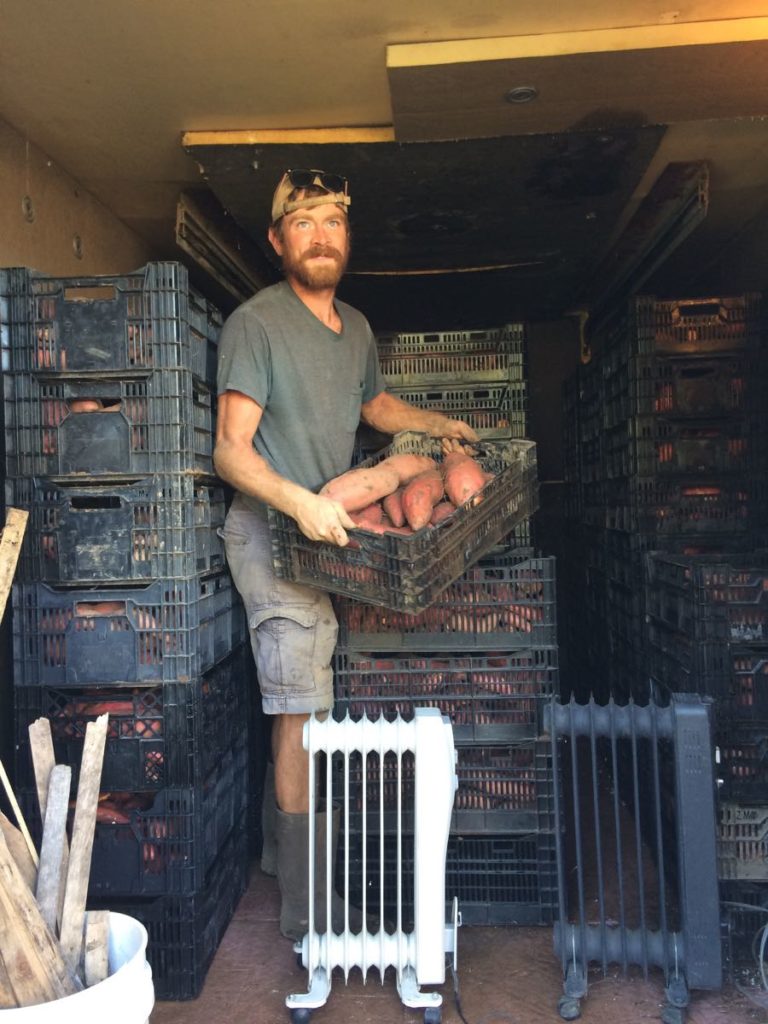
Billy (above), Kerry and Jory stacked the sweet potatoes in rows for good air movement.

Wetting down this week’s sweet potatoes before washing. We dug these ones about three weeks ago.
Veggie List and Veggie Notes
October 5/6, 2o17; week #21, purple EOW, sun SMP
Green cabbage
Sweet potatoes, ~2 lb
Romano beans, 1.9 lb
Edamame soybeans, 1 bundle
Red mizuna, 1 bunch
Winter squash, 1 or 2
Red onion
Slicing tomatoes, a few
Bell peppers, 2
Some sites get broccoli.
Some sites get cauliflower.
Next week’s box will probably contain winter squash, broccoli or cauliflower, kale or collards, peppers, carrots, scallions and more.
‘Beauregard’ sweet potatoes – Here are a few things we’ve learned about sweet potatoes:
– For best flavor, cook your sweet potatoes so they brown and caramelize. We have a simple, favorite way to roast sweet potatoes. We used to prepare sweet potato fries in the oven. Now we just quarter the potatoes, rub with olive oil, dust with salt and place cut-side-down on a cookie sheet. Roast in a 450 F oven without turning until soft. The flavors will caramelize (like sweet potato fries) but preparation is simpler and the cooking time less exacting. Slender sweet potato fries go from undercooked to overcooked in the blink of an eye. Larger slices are less exacting, and therefore are easier. Small sweet potatoes can be cut just in half. Jumbos will need to be chopped into pieces. Otherwise, they will take a long time to cook.
– Store your sweet potatoes at room temperature. They suffer chilling injury below 50 F.
– The sweet potatoes we grow require slightly longer cooking than ones from the supermarket, perhaps because they contain higher moisture so soon after harvest.
– Sweet potatoes are good at any size. We have cooked everything from tiny to jumbo and consistently find that all sizes taste good.
Romano beans – Steve says these are ‘meaty’ this week. They aren’t overripe. They are just big, perfect for braising recipes.
Edamame soybeans (bundle of green stems with pods attached) – These edible soybeans are a treat. Pull the pods from the stem and wash well. It helps to submerge the pods and rub them together. Boil in water until the pods have split and the beans are quite tender. Season with salt and pop the beans out of the pods into your mouth. This Japanese specialty is becoming more and more popular in the USA.
Storage: Remove the pods from the stems promptly and refrigerate.
Mizuna – Mizuna is similar to mustard greens but with the pepperiness of arugula. Good raw in salads or cooked in any recipe that calls for mustard greens. Cooking tames the pepperiness. Use the leaves and younger, more tender stems. Discard older stems as they can be tough.
Slicing tomatoes – I fibbed last week. These are the final tomatoes of the season. They aren’t as flavorful as summer tomatoes but are surprisingly good for this time of year. Thank the dry weather. You should refrigerate these tomatoes because they are not going to store well at room temperature. Eat soon.
Winter squash – You’ll get one of the types in the photo. They are ready to eat, and should be eaten within two weeks. Store your squash at room temperature on your kitchen counter where you can keep an eye on it.
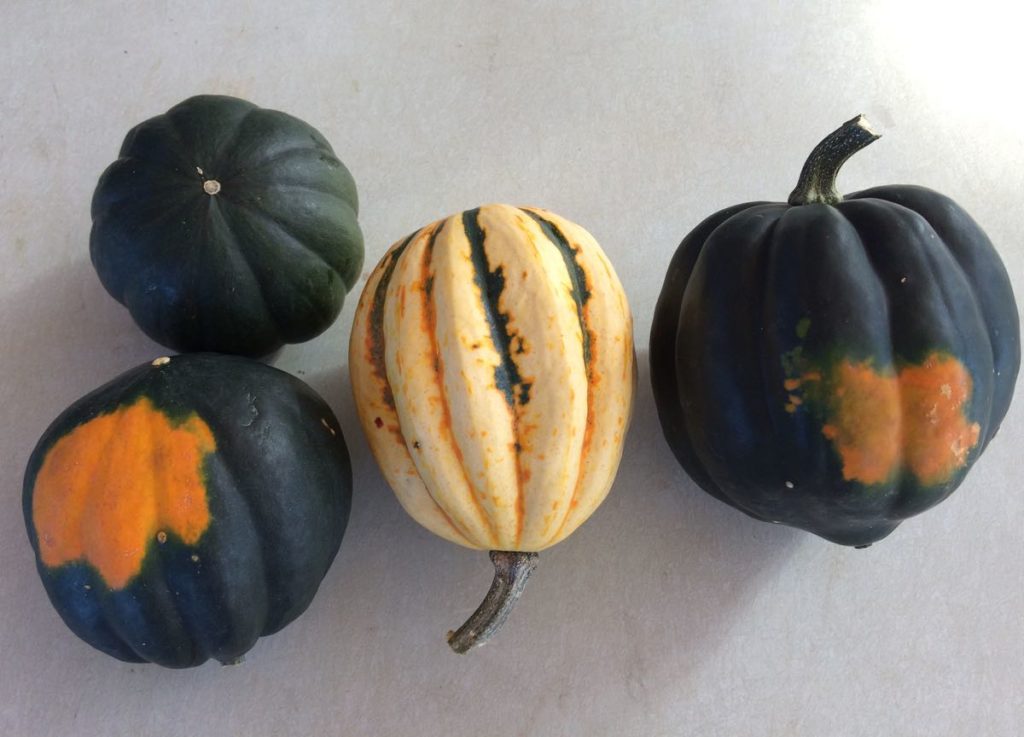
This week’s winter squash. Each site gets one type. From left, Sugar Bush acorn, Jester, TipTop acorn.
RECIPE LOG
Visit our Recipe Log, a list of all our 2017 recipes. Pat and Lauren have given us lots of broccoli and bean recipes already this year. Check out 9/21/17 for a few winter squash recipes.
LOCAL THYME RECIPES
Comforting Classics
Braised Mustard Greens
Minestrone with Peppers, Tomatoes, Cabbage and Romano Beans
Risotto with Braised Green Cabbage
Sweet Potato Puree
Outside the Box Recipes
Mizuna & Turkey Salad
Braised Romano Bean with Feta and Lemon Pepper
Slow Roasted Cabbage Chips
Chipotle Chicken and Sweet Potato Burrito
Quick and Easy Meal
Sweet Potato Posole with Black Beans
Week #20, Sept 29 2017
- On: September 27, 2017
 0
0
Register for November shares this week
We offer two shares to extend the CSA season into November, for hungry members who want to continue their local-foods adventure. Both shares focus on fall vegetables, roots, winter squash, etc. Go here to learn more and view sample boxes from previous years.
– Extension Share, $30, November 2/3 (Thurs/Fri sites), one delivery, same size box as the regular CSA deliveries (3/4 bu)
– Storage Share, $108, November 16/17 (Thurs/Fri sites), one delivery, two large 1 & 1/9 bushel boxes
Veggie List and Veggie Notes (Sept 28 2017; week #20, green EOW)
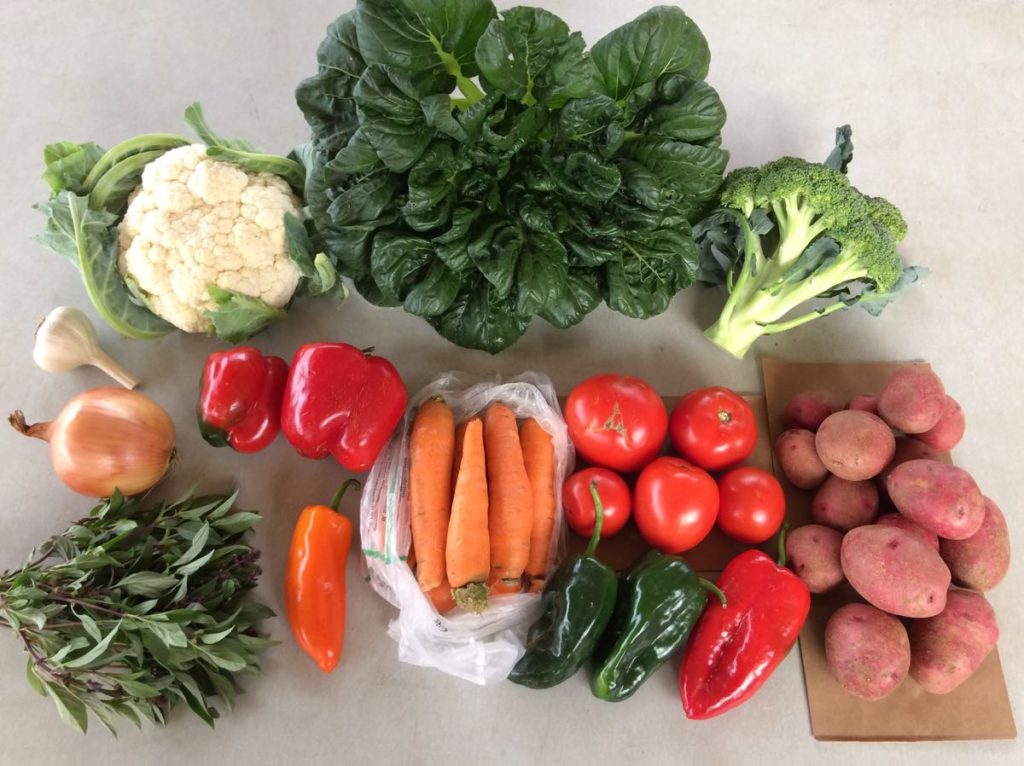
Beth’s box logic: – Wow, look at all the cabbage family vegetables in this box (cauliflower, broccoli, Koji or tatsoi greens). That’s what happens in fall. Stock up on your anti-oxidants this week.
– Roast your three poblano peppers. This is easiest on a grill. Peel the roasted chiles, cut into strips and use to top any dish this week. Great with any version of potatoes, or sprinkled into soup, or over top of casseroles, or cooked into scrambled eggs. We stir strips of roasted poblanos into tomato-pepper soup at the end of cooking.
– See below for a recipe to wilt your raw Koji greens. It’s a great technique to manage large heads of Asian greens.
Cauliflower, 1 large or 2 small
Broccoli, 1 large or 2 small
Koji OR tatsoi greens, 1 head
Red potatoes, 3.5 lb
Slicing tomatoes, 2.2 lb, see note
Carrots, 2 lb
Bell peppers, 2
Oranos peppers (orange, sweet), 1 or 2
Poblano chiles (mild heat), 3
Yellow onion
Thai basil
Garlic
Next week’s box will probably contain sweet potatoes, cauliflower or broccoli, cabbage, peppers, red onion and more.
Cauliflower – Woohoo! The cauliflower is ready and the heads are beautiful.
Koji greens (large head of dark green leaves) – Similar to other Asian greens like tatsoi or Yukina. We did not expect this to be ready until mid-October but it’s ready now. Cool weather in August was ideal for the young plants to get going. The recent hot spell sped them to maturity. These are really, really great. Consider trying my Wilted Choy Salad (below) if you are intimidated by large heads of Asian greens.
Red potatoes – These red potatoes are from our friends at Driftless Organics in western Wisconsin. This is a fresh batch of the red potato variety we got from them a few weeks ago. I found those to be excellent and more broadly useful than red potatoes often are. They were successful in potato salad yet they also roasted beautifully as oven fries.
Slicing tomatoes – These might be the final ripe tomatoes of the year. By this time of year, we recognize that tomatoes do not store well. Use them quickly; don’t try to hold them.
Poblano chiles (triangular, shiny, green or red) – These are mildly hot. Poblanos are the creme de la creme of chiles. They have lots of great flavor in combination with manageable heat. Roast and add to soup or casseroles. For our household, they are emblematic of fall cooking.
Garlic – This garlic is from John Hendrickson of Stone Circle Farm.
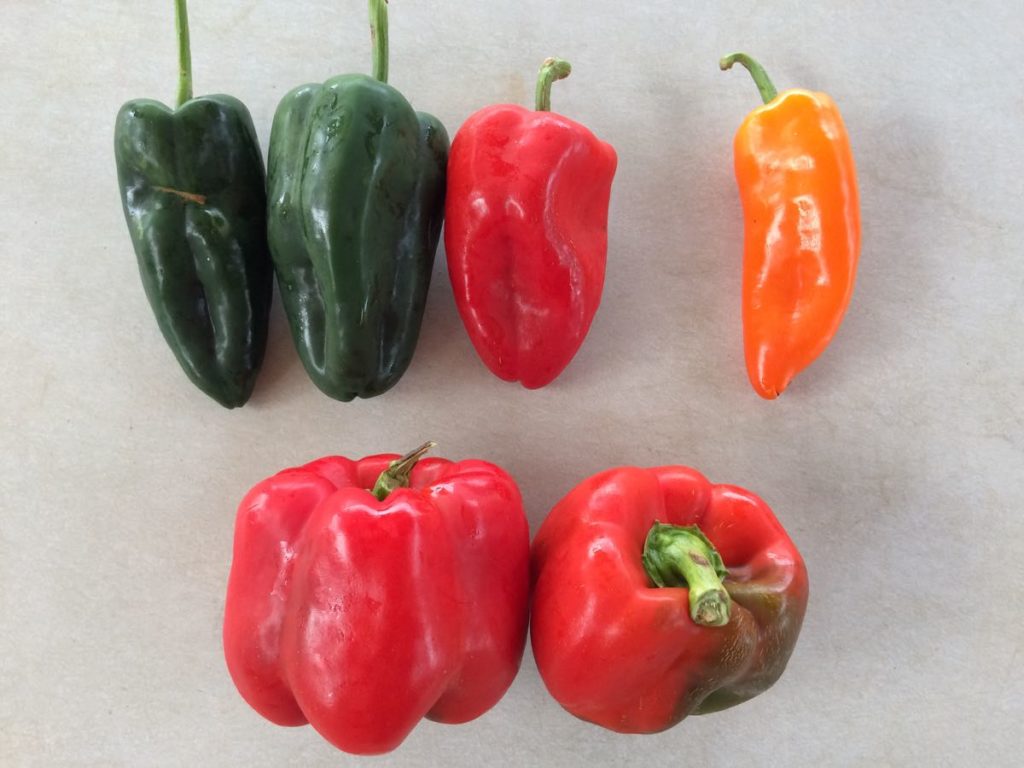
Pepper ID. Top left, poblano chiles (mild heat, triangular in shape, green or red).
Top right, Orano pepper (sweet, orange). Bottom, bell peppers (sweet, red or green).
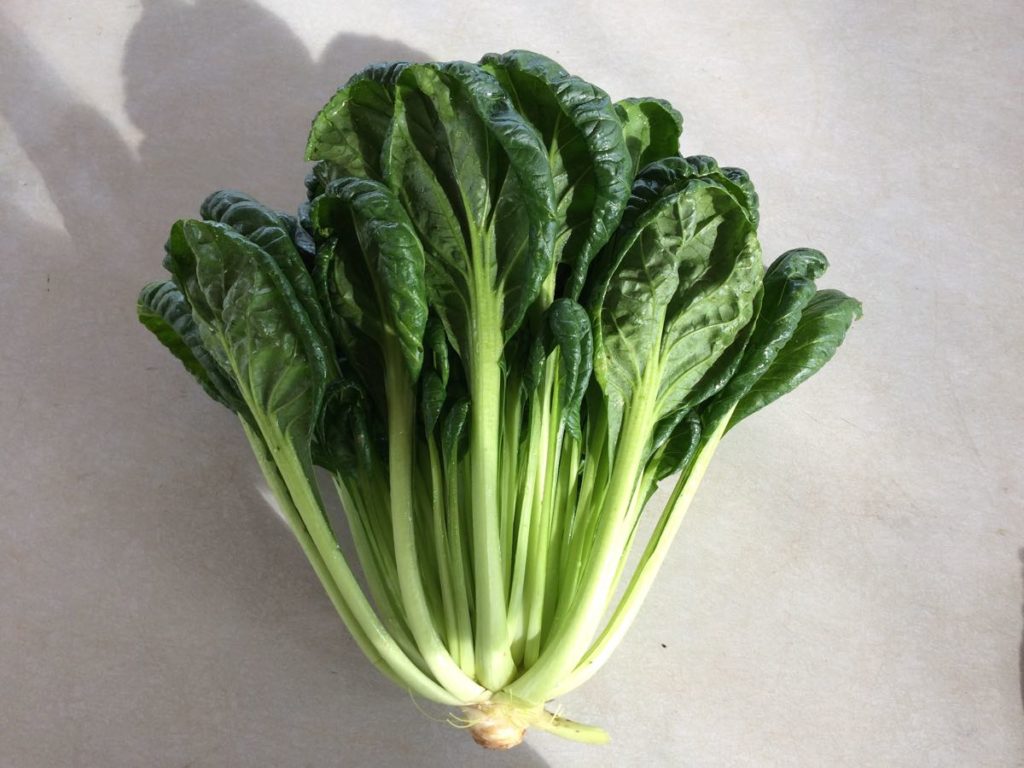
Koji and tatsoi are similar Asian greens. Eat both the leaves and stems.
RECIPES
Visit our Recipe Log, a list of all our 2017 recipes.
Recipe from Beth:
Succulent Wilted Choy Salad (aka “Tame That Choy” Salad)
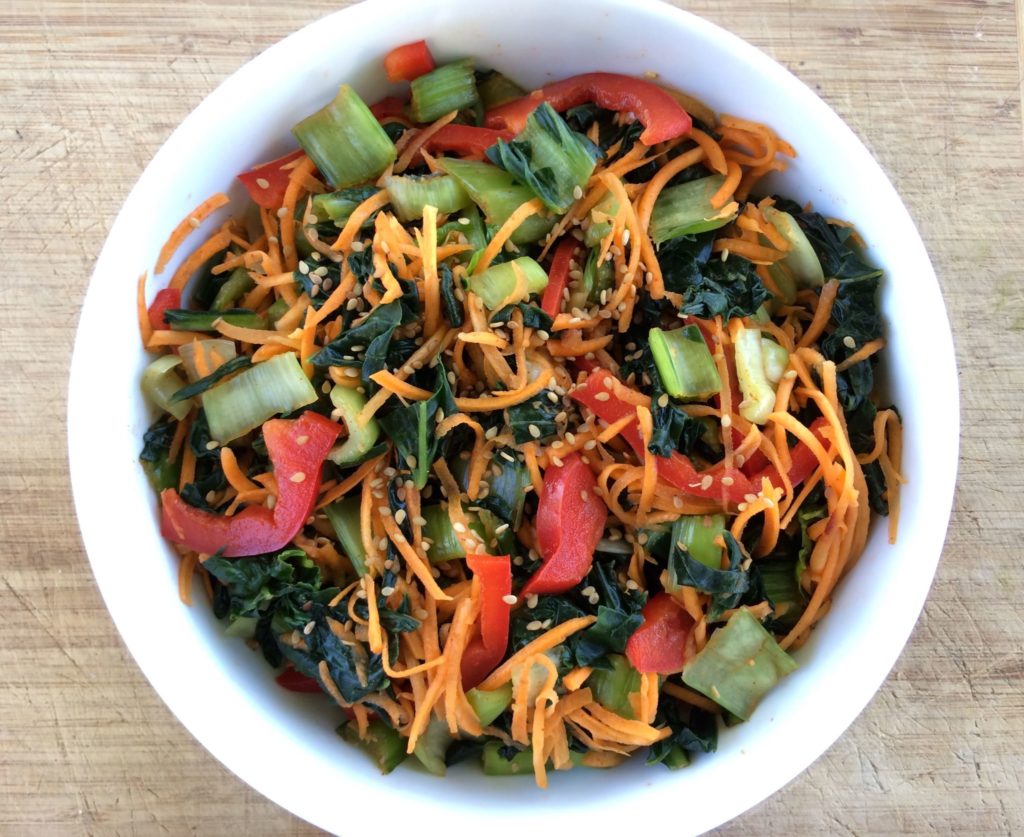
Large heads of bok choy or Koji greens can be intimidating. This technique shrinks raw greens without cooking, while preserving their peppery flavor. It’s a useful approach with bok or pak choy, Yukina, tatsoi or Koji greens. I’ve provided a dressing suggestion, but you can use any dressing you like, even bottled.
1 head Asian greens (bok choy, Yukina, Koji greens, or tatsoi), about 1.5 lb
salt
1 carrot, grated
1/2 red bell pepper, thinly sliced
2 scallions, sliced (optional)
1. Slice Asian green leaves and stems into 1/2 inch strips. Wash well in a basin of water. Drain in a colander.
2. Set the colander in a bowl or in the sink. Sprinkle 1 1/2 Tbsp salt over the greens and mix with your hands. This large amount of salt will be washed away later.
3. Wait 30 – 45 minutes. The salt will wilt the greens.
4. Rinse greens under running water, then dump into a fresh basin of cold water. Swish and drain, then repeat. Taste the greens. They will be slightly salty.
5. Squeeze most of the liquid from the greens. (Leave more liquid for thin-stemmed greens like Koji or tatsoi. Thick-stemmed bok choy will continue to release moisture after you assemble the salad.) In a large bowl, mix with the carrots and peppers. Dress with your favorite dressing.
Suggested dressing:
1 clove garlic, minced
1/2 tsp sugar
1 tsp soy sauce
2 tsp rice vinegar
1 tsp sesame oil
1/4 tsp paprika
pinch cayenne
toasted sesame seeds
Mix all dressing ingredients except the sesame seeds together in a small bowl. Dollop over the salad and massage together with your hands. Adjust the vinegar and soy sauce to taste. Sprinkle with toasted sesame seeds and serve.
LOCAL THYME RECIPES
Comforting Classics
Grilled Halibut with Yukina Savoy and a Thai Lime Sauce
Dried Apricot and Cauliflower Dal
Broccoli Cheddar Soup
Autumn Chicken or Veggie Pot Pie
Outside the Box Recipes
Tatsoi and Pecorino Salad
Mac, Cauliflower and Greens
Broccoli and Greens Soup
Vegetable Korma
Quick and Easy Meal
Roasted Tomatoes and Garlic Sauce with Ravioli
RECIPES FROM LAUREN
MEATLOAF WITH BROWN BUTTER MASHED POTATOES
This is one of my favorite dinner party meals. It feeds a crowd. It’s simple to make (especially if you have a food processor). It warms up well and incorporates loads of fresh veggies. If I were you, I’d make a pile of roasted broccoli and serve that on the side along with some sliced tomato. Lauren.
Takes 1 hour, 30 minutes
Serves 8-10
Tomato Glaze:
1/4 cup cider vinegar
2 tablespoons olive oil
2 tablespoons maple syrup
4 teaspoons Dijon mustard
4 teaspoons Worcestershire
3 large tomatoes, cored and finely chopped (about 2 cups diced), divided
1/2 teaspoon Kosher salt
Meatloaf:
2 pieces sandwich bread, food process, remove
2 carrots, roughly chopped
1/2 onion, roughly chopped
1 orano pepper, roughly chopped
2 garlic cloves
2 tablespoons olive oil
1-1/2 teaspoons Kosher salt, divided
1/4 teaspoon pepper
2 pounds ground beef
2 eggs
2 tablespoons Worcestershire
1 teaspoon Dijon mustard
1 teaspoon smoked paprika
Roasted broccoli, optional
Sliced tomato, optional
Mashed Potatoes:
3-1/2 pounds red potatoes, quartered
1 stick butter (1/2 cup)
1 cup whole milk
2 teaspoons Kosher salt
- In a small saucepan, combine all tomato glaze ingredients. Whisk together as best you can and then bring to a boil. Reduce to a simmer and let cook while you prepare everything else (about 45 minutes-1 hour), whisking occasionally to prevent it from sticking. You want the sauce to reduce to less than half its original amount and a consistency a little thinner than ketchup.
- In a large saute pan, melt butter for mashed potatoes. Continue cooking over medium heat until it begins to sizzle and then brown. It should smell nutty but not burnt. Use a spatula to remove all the delicious buttery bits from the pan to a small bowl.
- Preheat oven to 400 degrees and find two 9×13 baking pans.
- Next, begin to prepare your meatloaf. Tear bread into pieces and toss in a food processor. Process until it turns into crumbs. Remove to a large bowl. It’s fine if a few crumbs remain. Add carrots, onion, pepper and garlic to the food processor and process until finely chopped.
- In the same saute pan you browned the butter in, heat olive oil for meatloaf over medium heat until hot. Add chopped veggies and sprinkle with 1/2 teaspoon salt and pepper. Cook for 10 minutes until just starting to char in places. Add to bowl with breadcrumbs along with eggs, Worcestershire, Dijon, paprika and remaining 1 teaspoon of salt.
- Let the meatloaf mixture sit while you begin your potatoes. Add potatoes to a large stock pot, cover with water and bring to a boil. Once boiling, reduce to a simmer and cook for 25 minutes.
- Now, shape your meatloaves. You will want 12 small loaves total, six in each baking pan. Place in the oven. Bake for 10 minutes then remove and top with reduced tomato glaze. As much as you can get to stay on. Anything leftover can be served with the meal. Bake loaves an additional 10-15 minutes until brown on the edges and cooked through.
- Drain your potatoes. Return to the pot and mash as best you can. Add browned butter, milk and salt and mash until smooth.
- Serve potatoes with meatloaves on top. Throw some roasted and charred broccoli and/or sliced tomato on the side. Make sure to add any additional leftover tomato glaze to the loaves.
.
CAULIFLOWER RICE BURRITO BOWLS
Takes 45 minutes
Serves 4-6
1 large head cauliflower (or 2 smaller ones), leaves removed
1 yellow onion
2 tablespoons olive oil, divided
3 garlic cloves, minced
1 teaspoon Kosher salt, divided
2 limes, juiced, divided
1-1/2 teaspoons chili powder, divided
1 teaspoon cumin, divided
1/4 teaspoon oregano
2 red peppers, seeded and cut into strips
2 poblanos, seeded and cut into strips
1/4 teaspoon cayenne pepper
15-ounce can black beans
2 tomatoes, cored and diced
Simple guacamole (recipe below)
Sour cream, optional
Hot sauce, optional
- Using the large holes of a cheese grater (what you’d use to shred cheese), shred cauliflower into small pieces that resemble rice. Change the angle of the cauliflower so you get all the florets but not much of the stems. Set “rice” on a towel to remove excess moisture.
- Prepare your onion. Peel and halve it. Thinly slice half of the onion. Cut the remaining half in half again and thinly slice one of these quarters. Finely chop the other quarter and put both onion preparations to the side.
- In a large saute or sauce pan (that has a tight-fitting lid), heat 1 tablespoon olive oil over medium low heat. Add garlic and half of the diced onion. Sprinkle with 1/4 teaspoon salt. Cook gently until veggies become fragrant, about 3 minutes. Add the cauliflower rice and put the lid on. Cook for four minutes then remove to a medium bowl.
- Add half the lime juice, 1/2 teaspoon chili powder, 1/2 teaspoon cumin and 1/4 teaspoon dried oregano to cauliflower rice. Taste and adjust seasonings. Set aside.
- In the same pan you used for the cauliflower, add the remaining tablespoon of olive oil and heat over medium heat. Add the sliced onions, red peppers and poblano peppers and cook for 8-10 minutes until softened and even charred in places. Add 1/2 teaspoon salt, 1/2 teaspoon chili powder and cayenne pepper.
- While this cooks, combine black beans with remaining salt, chili powder and cumin in a small saucepan. Cook over medium low heat until warm.
- Serve in bowls with cauliflower rice on the bottle and all desired toppings. I love the beans and peppers with diced tomatoes, guacamole, sour cream and hot sauce.
.
SIMPLE GUACAMOLE
4 avocados
1 garlic clove, minced
1 poblano, finely diced
1/4 cup diced onion (reserved from above)
1 lime, juiced
1/4 teaspoon Kosher salt
- Place avocados in a medium bowl. Mash with a fork.
- Add remaining ingredients and stir to combine. Taste and adjust seasonings as desired.
.
Week #19, Sept 21 2017
- On: September 20, 2017
 0
0
Scenes from the week
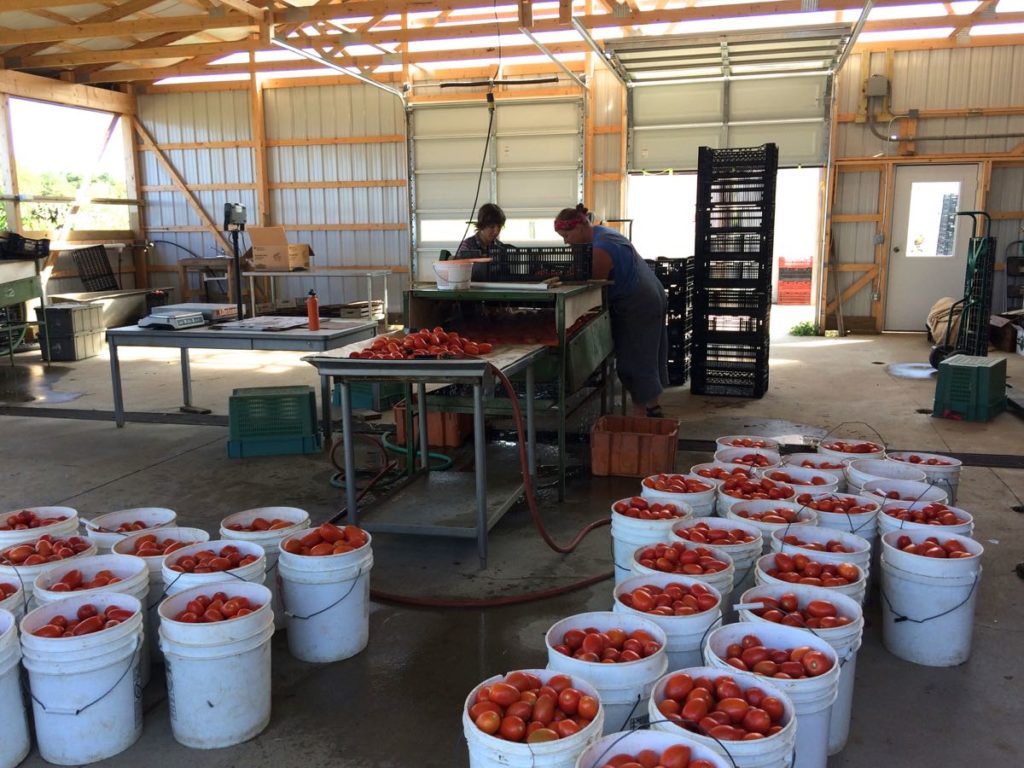
The tomatoes are still going strong. We can thank the dry weather for that. At top, Kerry and Kelsie wash plum tomatoes. The improved light in our new shed is wonderful. We’ve enjoyed it all season.
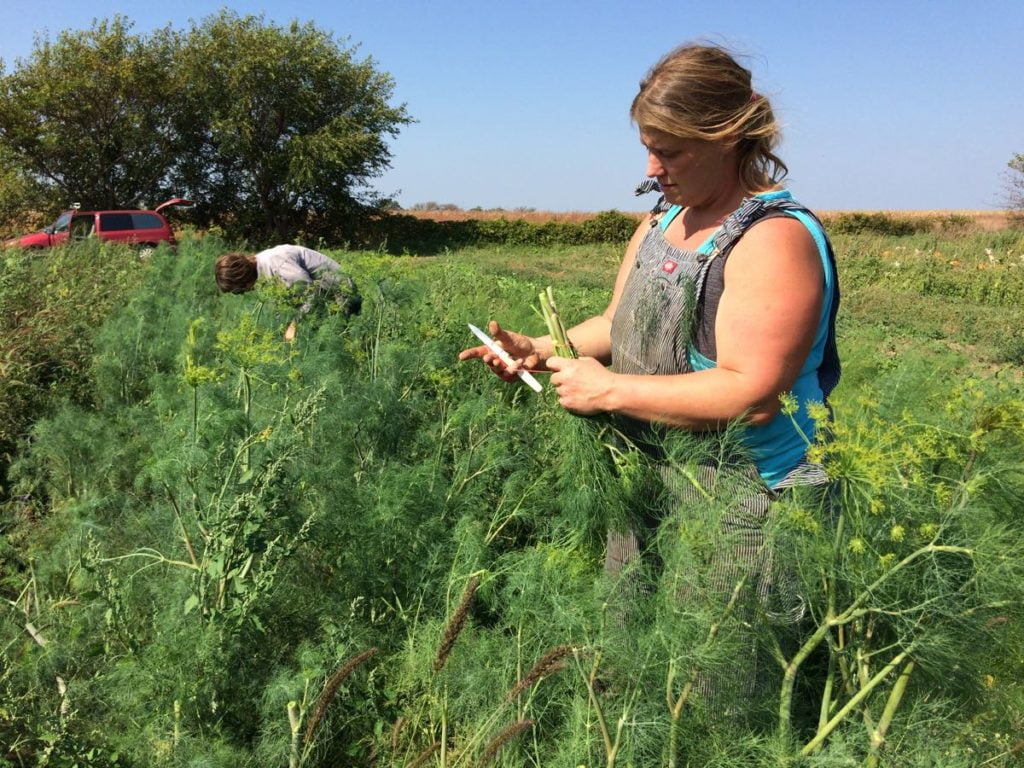
Charlotte and Maggie bundle dill for the CSA boxes.
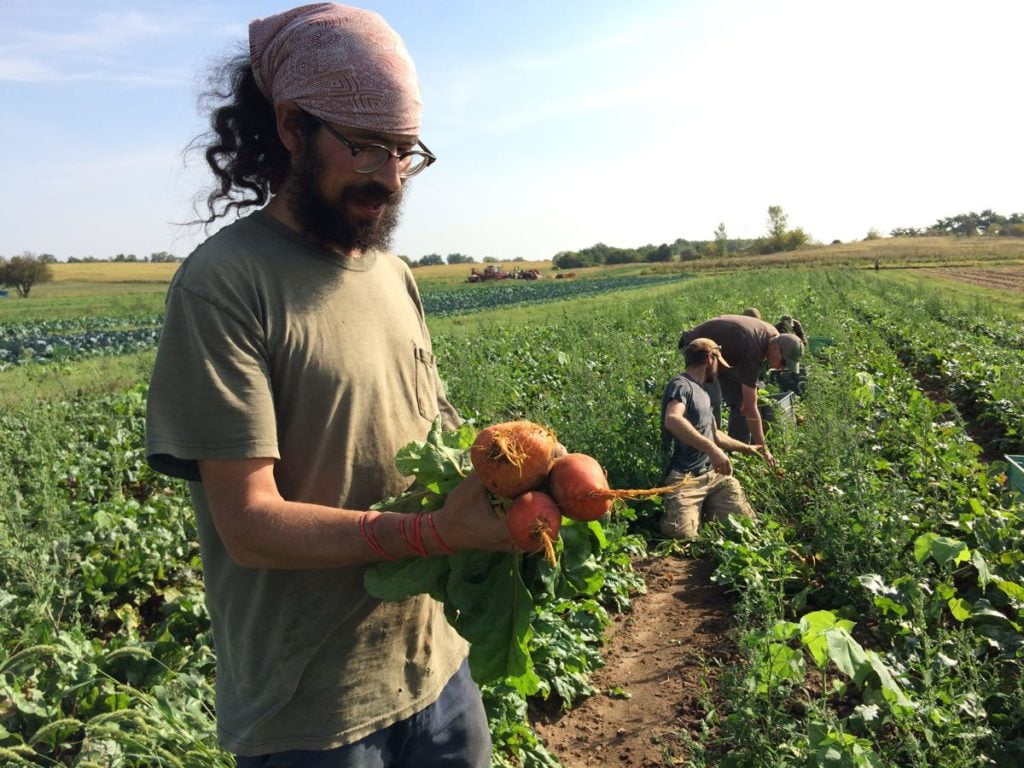
Small scale, big scale. Smitty, Billy, Matt, Jim, Jose, Raul and Kelsie bundle golden beets with the greens attached. We do this task by hand. Really, it’s the only way to do a quality job.

In a nearby field, Steve harvested carrots mechanically. With our root digger, we can harvest 1000 lb carrots in 30 minutes with just three people. Without this sort of tool we couldn’t grow enough carrots to feed you all winter.
WINTER SQUASH
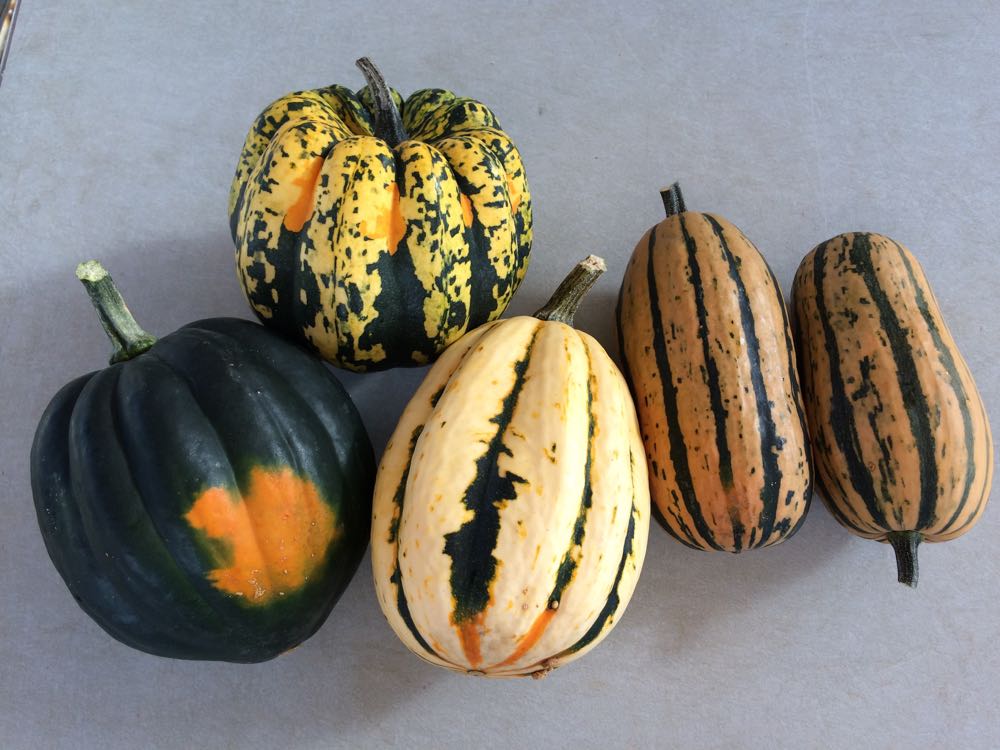
From left, TipTop acorn, Carnival acorn, Jester (an acorn x sweet dumpling hybrid), Honey Boat delicata (2/box).
We harvested a variety of early maturing types for this week’s box. You will receive one of these types. Some are new-ish varieties for us. We trial new varieties for a few years before scaling up and each of these types made the cut. I think these are all winners but I’d like to hear what you think of them. There’s a limit to how many I can sample!
Expected life: These acorn and delicata types do not store for long. Plan to eat within two weeks.
Storage: Store at room temperature, uncovered.
To make squash easier to cut: Microwave on high for 30 to 60 seconds, depending on size of the squash. This will soften the rind and flesh, making it much easier to cut.
Beth’s favorite simple preparation: Winter squash are easily roasted in a 400F oven. Microwave your squash to soften it. Split in half with a sharp knife. Scoop out and discard seeds. Run the squash under running water and shake off the excess water. Place cavity-side-down on an oiled baking sheet. The little bit of moisture helps seal the squash to your roasting pan. The water soon evaporates, allowing the squash to brown and caramelize. The caramelization really boosts the flavor. Roast at 400F until easily pierced with a fork, 20 – 45 minutes depending on size. Flip over while hot. Add a little butter to melt and some seasoned salt. Cut into wedges and eat.
Can you eat the rind? Well, Steve eats the rind for all these types but he’s a little crazy. In my opinion, the rinds are too thick to eat on the acorn types (TipTop, Jester, Carnival). Delicata skin is usually thin enough to eat but this durable Honey Boat variety has a somewhat thicker rind than usual. I don’t eat it; Steve does.
Stuffed squash: Each of this week’s types has a central cavity that can be stuffed. Prepare your favorite fully-cooked stuffing, e.g. a rice or quinoa mixture. Roast your squash as described above. Preheat the stuffing. Fill the cooked squash with stuffing, top with grated cheese and return to the oven until everything is hot.
Veggie List and Veggie Notes
Sept 21/22, 2017, week #19, purple EOW, moon Sampler
Beth’s box logic w.r.t. dill:
– Your dill will be a bundle of both flowers and leaves. Use the flowers to make a dilly-bean salad or some refrigerator dilly-beans, similar to refrigerator pickles.
– Dill leaves combine well with broccoli, so think about an egg-broccoli-dill dish, along the lines of a quiche or frittata.
– Cream of tomato soup with dill is really, really good. Use your favorite tomato-basil soup but substitute dill for the basil, and reduce the amount. Use a light hand with the dill if you’re planning to save soup for leftovers. Dill tends to strengthen over time in tomato soup.
Golden beets with greens, 1 bunch
Broccoli, 1 or 2 nice heads
Winter squash, 1 medium or 2 small, see notes
Tomatoes, slicing, ~2 lb
Tomatoes, plum, ~2 lb
(Both types are in one paper bag.)
Carrots, 2 lb
Green beans, ~0.7 lb
Red bell peppers, 2
Yellow onion
Dill, 1 bunch
Jalapeno chile (HOT), 1
Garlic
A few sites get an heirloom tomato or a cucumber or some extra beans.
Next week’s box will probably contain broccoli, potatoes, tomatoes, peppers, spinach and more.
Golden beets with greens – Beet greens are tasty, similar to Swiss chard in flavor, texture & cooking time. These two crops are very closely related. You can remove the thickest midribs before cooking if you wish, but it is not essential. Storage: Cover and refrigerate. Separate the tops and roots if you don’t plan to eat the greens immediately, to preserve freshness in the roots. Beet greens are perishable and should be eaten soon. The beet roots will last for weeks.
Broccoli – 2017 continues to be a good broccoli year. Broccoli needs a lot of water at its adolescent stage and this planting certainly got it this summer.
Yellow onion – This week’s onion is an intermediate type which will fry successfully yet is not as pungent as a typical yellow storage onion.
Dill – You’ll get a bundle with both flowers and leaves. Ideas: See above.
Winter squash – See above.
RECIPES
Visit our Recipe Log, a list of all our 2017 recipes.
RECIPES FROM LOCAL THYME
Comforting Classics
Golden Beets with Citrus and Greens
A Hungarian Goulash
Asian Stir Fry with Broccoli, Peppers, Beet Greens and Beef
Baked Winter Squash with Tomatoes
Outside the Box Recipes
Farro Salad with Beets, Broccoli, Dill and Walnuts
Orange Scented Pork with Tomatoes and Onions
Black Bean, Broccoli and Cheese Stuffed Bell Peppers
Winter Squash Agrodolce
Quick and Easy Meal
Black Bean, Shredded Carrot and Pepper Burrito
Week #18, Badger on the farm!
- On: September 13, 2017
 1
1
While puttering in our sand pit one day in July, I looked up and saw a badger peeking out of its den. This is quite rare; badgers are elusive. I took the video below with my cell phone. You can see that the badger was curious about me too.
This creature has brightened my summer, even though I have not seen it again. It continues living in our sand pit, digging extensive tunnels within the walls of the pit and in the nearby tree line. I find fresh prints and digging every day. Before noticing the badger, I visited the sandpit frequently in spring, planting prairie seedlings along its dry walls. The badger has dug tunnels everywhere except the area I planted. Perhaps it recognizes that as my territory. At first, I worried about disturbing it but then I saw this video of various animals romping outside badger dens in southern Wisconsin.
The sandpit is a special place for our family. The previous owners of our farm sold sand for road construction, leaving an open bowl-shaped pit in a hillside. Over the years, it was a giant sandbox when our children were young, then a sled run, then a sheltered and exotic fire pit. We’ve ceded it to the badger for now. Beth
#2 Grade Red Peppers
I write about pepper grading every year. Returning members can say “yeah, yeah” and skip ahead. New members, please read.
Many of the red bell peppers we send in the CSA boxes will be our #2 grade. We do this to avoid waste and to deliver good value to our CSA members. The #2 grade peppers are excellent eating quality, but are not quite pretty enough to sell to stores. As a result, we place a much lower value on these peppers. This allows us to provide generous amounts of peppers over the course of the season. We feel this is a good exchange, even if it means you occasionally open a pepper and find that it needs trimming. Here are the reasons that peppers are downgraded from #1 grade to #2 grade:
- They may have a minor blemish, or
- They may have minor insect damage, or
- They may be very ripe and beginning to wrinkle. (These are especially sweet and delicious as they are fully ripe. These cannot be sold to stores because their shelf life is short. You will find that the texture is less crisp than a #1 grade pepper, but the flavor more than makes up for it.)
- They might be partially red and partially green.
- Others are just too small.
The eating quality is fine (or excellent) for all these #2 peppers. We throw away all peppers that we suspect have rot inside (although one may occasionally slip through in either #1 or #2 grade.) Today’s peppers are a mix of #1 and #2 grade.
Veggie List and Veggie Notes (week #18, Sept 14/15, green EOW)
Slicing tomatoes, ~4.4 lb
Green beans, 1.2 lb
Celery, 1 head
Red peppers, 3 – 4, mostly red frying peppers
Swiss chard, 1 bunch
Leek, 1 or 2
Yellow onion, 1 medium
Lettuce, red or green leaf
Zucchini/squash, ~1
Cucumber, ~1
A few sites get an heirloom tomato.
Next week’s box will probably contain tomatoes, peppers, onion, green beans, some kind of greens and more.
Celery – Our celery is more strongly flavored and more fibrous than typical grocery store celery. Taste it raw then decide how you want to use it, raw or cooked. This is one of our better batches of celery, which we pack in the CSA boxes just once per year. We’ve pushed the planting date later. We want to avoid summer harvests because the celery is tough if it matures during hot weather. Harvest too late in the fall and insect problems accumulate. Who knew celery is so finicky to grow?
Frying (long) and bell (blocky) peppers – You’ll get 3 or 4 peppers this week, based on size. Everyone gets frying peppers but some get frying peppers plus a bell pepper. Frying peppers have lower moisture, making them ideal for browning in a pan with a little oil. You can also roast them in the oven. I cut into pieces, lightly oil and put close to the broiler until they are a bit charred. It doesn’t take much broiling to develop the roasted flavor.
Yellow onion – This week’s onion is a yellow storage onion, the type you’ll find most often in the grocery store. These are pungent and will fry well.
RECIPES
Visit our Recipe Log, a list of all our 2017 recipes. Check June 29 for other cabbage and Swiss chard recipes.
RECIPES FROM LOCAL THYME
Comforting Classics
Wilted Chard with Almonds
Summer Squash, Green Bean and Tomato Sauté
Braised Sausage, Peppers and Onions
Tuna Noodle Casserole
Outside the Box Recipes
Sausage, Brown Rice and Lentil Stuffed Chard
Pungent Green Beans and Tomatoes with Cumin, Garlic and Ginger
North African Roasted Vegetable Salad
Mozzarella and Celery Salad
Quick and Easy Meal
Red Bean Jambalaya
RECIPES FROM LAUREN
GREEN BEANS with ROMESCO SAUCE
Adapted from Naturally Ella
Though technically a side dish, I absolutely have a meal in mind for you here. Do yourself a favor and pick up some tuna steaks from the grocery store and then serve this simple dish on the side of seared tuna. Tuna and romesco is one of my all time favorite combinations and the addition of crunchy, gently blanched green beans is just heavenly. Lauren.
Takes 1 hour
Serves 4 as a side
2-3 Italian frying peppers
1-1/2 cups unsalted roasted almonds, divided
1/4 cup diced leek (if you made the African peanut stew, just make sure you leave this much on the side)
1 small to medium tomato, cored and seeds removed
2 tablespoons red wine vinegar
1 tablespoon smoked paprika
1/2 teaspoon Kosher salt
1/4 teaspoon freshly ground black pepper
1/4 teaspoon cayenne pepper
1/4 cup olive oil
1+ pounds green beans
- Preheat the broiler of your oven and bring a large pot of salted water to a boil on the stove.
- Place peppers on a baking sheet and let cook under the broiler for 15-25 minutes (it will vary a lot based on how hot your broiler can get), turning occasionally until blackened (and I mean really blackened) on all sides.
- Remove from oven, place in a bowl and cover with a plate. Allow to cool for 30 minutes for easiest peeling.
- While the peppers roast, trim the ends of your green beans and submerge them in boiling water for three minutes. Drain and rinse with cold water until cool to the touch. Leave in colander to drain further until ready to use.
- In a separate small pan, toast remaining almonds over medium heat until lightly browned and fragrant. Set aside.
- Once peppers have rested, remove from bowl and peel the skin away. Remove the seeds and toss the peppers into a food processor. Add 1 cup of almonds, leek, tomato, vinegar, spices and oil to food processor. Process until mostly smooth.
- Toss with cooled beans in a large bowl and sprinkle with remaining almonds.
.
AFRICAN PEANUT STEW
This time of year, the meal I’m always dreaming of is African peanut stew. I’m not sure why but for me it’s the quintessential mid-September dishes. It uses up a few pounds of tomatoes without being too tomato-forward and the spicy flavors warm you through September’s coolest nights. The peanut butter adds heft to a meal that would otherwise almost be too light. It’s a stick to your bones kind of a meal and everything I’m craving this time of year. Lauren.
Serves 4-6
Takes 50 minutes
2 tablespoons butter
1 yellow onion, diced
1 large leek (white and pale green part only), halved and sliced
1 teaspoon Kosher salt plus more to season
1/4 teaspoon freshly ground black pepper
1 bunch chard, divided
2 stalks celery, diced
1 red Italian frying pepper, seeded and diced
1 zucchini, cut into space cubes
1 teaspoon red pepper flakes (if you have a jalapeno or other hot pepper lying around from a previous week just dice that and throw that in instead)
1 teaspoon ground ginger
2 teaspoons ground cumin
1/4 teaspoon cayenne powder
2 pounds tomatoes, cored and diced
4 cups vegetable stock
1/2 cup peanut butter
1/4 cup brown sugar
For serving:
2 cups cooked rice
1/2-1 cup roasted peanuts
1-2 limes, quartered
- In a large stock pot, melt butter over medium heat. Add onion, leek, salt and pepper. Saute for 5 minutes until softened and fragrant.
- While that cooks, remove the chard stems from the leaves. Very thinly slice the stems and throw them into the pot with the onions and leeks. Roughly chop the chard greens and set them aside for later use. Add celery, red pepper and zucchini. Saute 2-3 minutes longer until all the veggies have softened. Add spices and continue to cook for 2-3 minutes. You want the spices to become fragrant and toast ever so slightly but not burn. The second you smell even the faintest burnt flavor, add the tomatoes. Simmer for 15 minutes until significantly reduced.
- Add vegetable stock, peanut butter, and brown sugar. Continue simmering very gently for another 15 minutes. Add chard leaves and cook until just wilted. Taste and adjust seasonings. You may want a little more salt, sugar or spice.
- Serve over cooked rice with peanuts and lime juice.
.
Week #17, Sept 7 2017
- On: September 06, 2017
 0
0
Veggie List and Veggie Notes (Sept 7/8, 2017, week #17)
– Weekly members
– Purple EOW
– Sun sampler
Beth’s notes: This box is loaded with solanaceous crops (tomatoes, potatoes, eggplant, peppers, chiles). This is an excellent week to make ratatouille. Remember, Pat gave us a recipe for Ratatouille Provencal earlier this season. Pat and Lauren’s recipes are always appealing but they have come up with an unusually appetizing set this week.
Red potatoes, ~ 3.3 lb
Globe eggplant, 1 or 2
Green or red leaf lettuce
Slicing tomatoes, ~5 lb
Bell or Orano peppers, ~2 (or 3 if small)
Zucchini/squash, maybe 1.5 lb
Cucumber, ~1
Yellow onion
Anaheim chile, 1
Garlic
A few sites get one heirloom tomato per box.
.
Next week’s box will probably contain tomatoes, peppers, leeks, lettuce, beans, some kind of green and more.
.
Bok choy (large rosette with thick white stems and green leaves) – This Asian green is good for stir-frying or sautéing or in soup. You can think of the stems and leaves as two separate vegetables. The stems require longer cooking. The leaves will cook almost as quickly as spinach. Bok choy stores well, so feel free to pull off leaves as you need them, or use the whole head at once. Refrigerate in a plastic bag.
Red potatoes – These Red Norland potatoes are from our friends at Driftless Organics.
Yellow onion – This week’s onion is an intermediate type. They are not very pungent but not as mild as a Walla Walla. They are fairly moist but you can brown them successfully.
Heirloom tomatoes (ONLY AT SOME SITES; a large tomato that’s not in the paper bag with the other tomatoes) – We will rotate heirloom tomatoes among the sites as they ripen. Heirloom tomatoes are full-flavored but delicate. If you receive one this week, please handle it very gently, as these fragile beauties bruise easily. Some are delivered ripe, some need to ripen at room temperature for a day or two. Plan to eat your heirloom as soon as it is ripe. FYI, we did not wash the heirlooms this week, in an effort to minimize handling and bruising. Just give it a gentle wash when you are ready to eat it.
Anaheim chiles (MEDIUM HEAT, long slender peppers, red or green) – Anaheims usually have medium spiciness although it varies from pepper to pepper. As usual, the heat is concentrated in the seeds and midveins. Remove the seeds and midveins is to lessen the chili’s heat. Anaheims are easily mistaken for Italian frying peppers. We never send them in the same box for that reason. Keep this in mind if you have peppers left over from previous weeks.
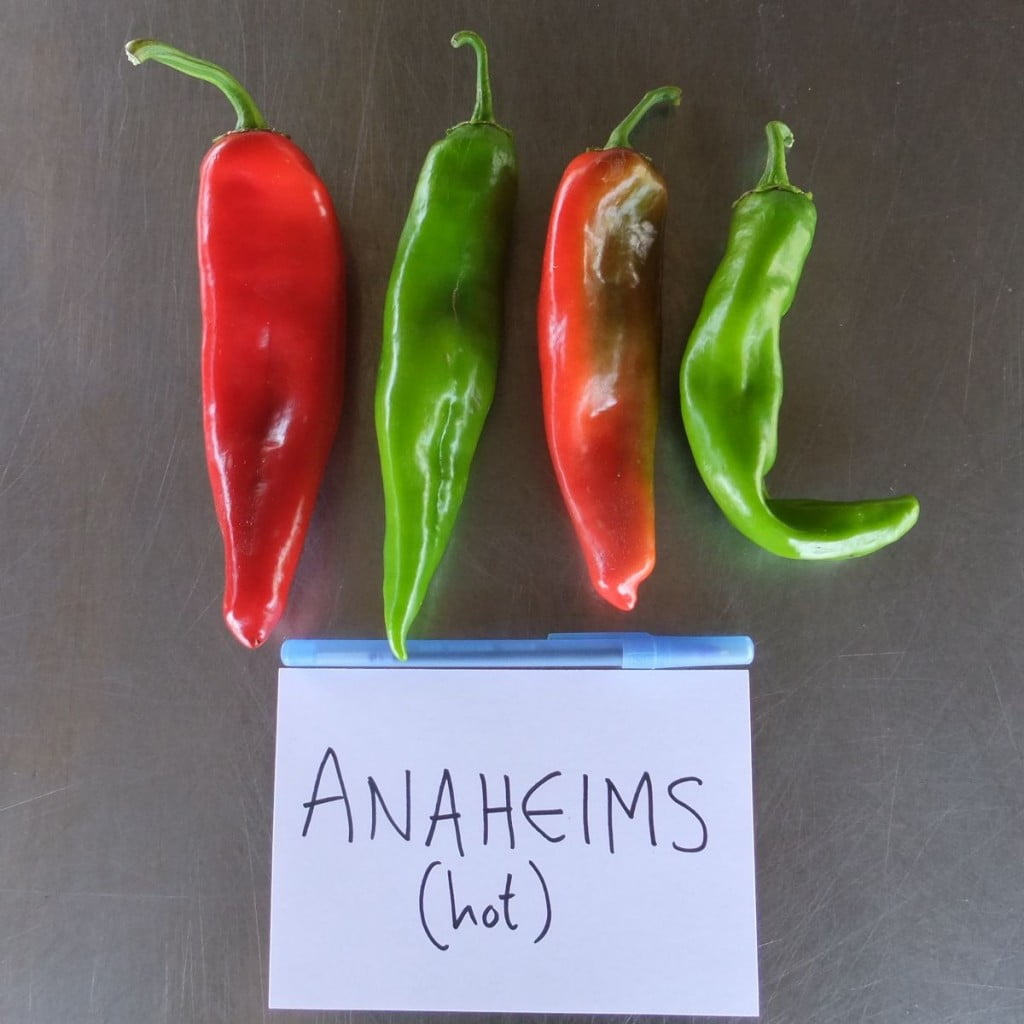
The only slender green or red peppers in your box this are spicy Anaheims. Slender orange peppers are sweet Oranos. Bell peppers this week are blocky and could be green, red, yellow, orange or purple. Everyone gets two sweet peppers this week (or three if they are small). Everyone also gets one Anaheim.
RECIPE LOG
Visit our Recipe Log, a list of all our 2017 recipes to date.
LOCAL TIME RECIPES
COMFORTING CLASSICS
Fresh Marinara
Korean Style Bok Choy Fried Rice
Zucchini, Tomato and Eggplant Tian
Potato and Sweet Pepper SM-Hash with Smoked Salmon or Trout and Poached Eggs
From earlier this year: Ratatouille Provencal
OUTSIDE THE BOX
Charred 2 Pepper and Tomato Salsa
Bok Choy Kimchi
Rigatoni with Roasted Eggplant, Capers and Anchovies
Summer Squash, Potato and Tomato Tagine
QUICK AND EASY MEAL
Salad with Tuna, Olives, Cucumbers, and Onion Vinaigrette
RECIPES FROM LAUREN
FARM STAND QUINOA BOWL
Adapted from my farming buddy Andrea Bemis. Lauren
Takes 1 hour
Serves 4-6
2 cups cooked quinoa (or grain of your choice)
1 anaheim chili, seeded and diced
1 bell pepper or 2 orano peppers, seeded and diced
2 tablespoons olive oil, divided
1 pound zucchini, halved and cut into 1/4-inch slices
1/2 Expression onion, sliced
Kosher salt and freshly ground black pepper
2 pounds tomatoes, cored and sliced
15-ounce chickpea
1 teaspoon paprika
Tahini Dressing:
1/4 cup tahini
1/4 cup water
1 garlic clove, minced
2 tablespoons lemon juice
2 tablespoons olive oil
2 teaspoons honey
1/2 teaspoon Kosher salt
1/8 teaspoon freshly ground black pepper
Pinch cayenne pepper
- Preheat oven to 450 degrees.
- Cook your quinoa (or grain of your choice). I always follow these directions for perfect results.†Once cooked, add diced peppers and set to the side.
- On a large baking sheet, drizzle with 1 tablespoon olive oil. Add zucchini and onion to pan and sprinkle generously with salt and pepper. Bake for 15 minutes. Move veggies to one side of the pan and add sliced tomatoes to the other. Season with salt and pepper. Roast 25 more minutes. At this point, veggies should begin to look charred. If not, turn on the broiler and cook 5-10 more minutes.
- Meanwhile, while the veggies cook, heat remaining olive oil in a large saute pan over medium high heat. Add chickpeas and 1/2 teaspoon Kosher salt. Cook for 15 minutes until chickpeas are golden brown and crispy. Remove to paper towel to drain grease and then toss with paprika.
- Prepare the dressing by combining all ingredients in a small bowl and whisking until smooth.
- To serve, scoop quinoa into large bowls. Top with roasted veggies and drizzle with dressing. Add crispy chickpeas just before serving.
.
PAN-FRIED EGGPLANT with BUTTERMILK DRESSING
Adapted ever so slightly from Bon Appetit. Lauren
Takes 30 minutes
Serves 2-4
1 eggplant, quartered and cut into 1/4-inch slices
4 tablespoons olive oil, divided
Kosher salt
1 cucumber, seeded, quartered and sliced
1 tablespoon lemon juice
1/2 lemon zest
2 avocados, cup into 1/2-inch slices
Buttermilk Dressing:
1 tablespoon olive oil
1/2 Expession onion, diced
Kosher salt
2 tablespoons yogurt
2 tablespoons white wine vinegar
1/2 tablespoon honey
1/2 tablespoon Dijon mustard
1 garlic clove, minced
2 tablespoons olive oil
- Begin with the dressing. In a large, heavy saucepan (use a cast-iron skillet if you have it!) heat olive oil over medium high heat. Add onion and saute gently for 5-7 minutes for until the onions begin to be charred (and smell almost burnt). Sprinkle generously with Kosher salt and remove from heat.
- In a small bowl, combine yogurt with vinegar, honey, mustard and garlic. Whisk until smooth then add sauteed onion. Stir in olive oil and set aside to marinate.
- In the same large pan you cooked the onions in, heat two tablespoons olive oil over medium high heat. Add half the eggplant in a single layer and sprinkle with salt. Cook for 3-4 minutes without moving until browned. Use tongs to flip and cook 2 minutes longer. Remove to a large bowl. Add remaining olive oil to pan and repeat browning with remaining eggplant.
- Add cucumbers followed by lemon juice and lemon zest. Gently fold in avocado.**
- Transfer to a platter and drizzle with dressing. Enjoy at room temperature (with a grilled pork chop if you’re anything like me).**
**If you aren’t planning to eat all the salad in this one sitting, place as much avocado as you plan to use on a platter and top with proportionate amounts of salad. Drizzle with dressing.
.
Week #16, August 31 2017
- On: August 30, 2017
 0
0

Steve doffs his cap in the watermelon field. The vines and leaves look normal but the melons are rotting.
Folks, this might be your final melon for the season.
A new disease is wreaking havoc in our large, third melon planting. Nearly all the watermelons in that acre have been infected and are quickly collapsing. We’re sorry that some of you did not get your usual quota of watermelons! As I wrote last week, we have sent lots of muskmelons this year because they’ve been so good and we wanted to get them to you during the short muskmelon season. We assumed that watermelons would remain abundant in September as usual. The disease is related to all the rain. Considering how wet it’s been, we really haven’t had many losses until now so we can’t complain.
This week’s melons came from an unaffected field but almost all those melons are now harvested.
We’re doing our research, talking with extension experts and figuring out how to keep the disease from spreading. Steve ran samples to the disease diagnostic clinic in Madison immediately, to get the disease identified (Phytophthora Blight). Over the years, we’ve learned to move quickly when problems arise. We’ll pull and destroy isolated disease patches. Amanda Gevens, the vegetable pathologist for Wisconsin, suggests looking into some of the available plant oils like rosemary, clove, and peppermint. If nothing else the field will smell good.
Steve is really bummed. Watermelons are his favorite crop, plus we know you’ve been waiting for watermelons. Beth
Veggie List and Veggie Notes
(Aug 31/Sept 1, week #16, green EOW)
Beth’s notes: Let’s call this “An Almost Salsa” box.
You’ve got tomatoes, peppers, jalapeño chile and onion, everything you need, as long as you substitute parsley for the traditional cilantro. You can even add corn kernels. The cilantro will be ready in a few weeks. We lost two seedings during the heavy rains in July but have re-planted.
You will receive most but not all of the items on this list:
Sweet corn, ~8 ears
Yellow watermelon
Slicing tomatoes, 3.25+ lb
Bell pepper, ~2
Fennel, 1 bulb with fronds
Cucumber, ~2
Zucchini/squash, 1 – 3
Grape tomatoes, 1 pint
Walla Walla onion
Flat parsley, 1 bunch
Jalapeno chile (HOT), 1
Garlic
Next week’s box will probably contain potatoes, tomatoes, onion, peppers, lettuce and more.
Sweet corn – This is the final sweet corn planting.
Fennel (large vegetable with a fat bulb and lacy fronds) – Fennel is a ‘swing vegetable’; it can be used raw or cooked. Clean well and slice as thinly as possible for use in raw salads. It is good simply prepared with olive oil, lime or lemon juice, salt and shaved parmesan cheese. Cooking softens and sweetens fennel, and mellows its anise flavor. Both the bulb and leaves are edible. Here are ideas from Alice Water of Chez Panisse about how to use fennel: ‘It’s strong anise characteristic seems to suit fish particularly well. … We use fennel all the time. We add the feathery leaves to marinades for fish and to numerous salads, sauces and soups and we use them as a garnish, too. … The bulbs are sliced and served raw in salads in various combinations with other vegetables, parboiled for pastas; caramelized and served as a side dish; braised whole; or cooked in vegetable broths & fish stocks.”
Grape tomatoes – We’ve experimented with new varieties and think you are going to like these tasty grape tomatoes.
Jalapeno chile – These are HOT. If you want to diminish the heat, remove and discard the seeds and midveins. That’s where the heat concentrates. Wear gloves if you are sensitive.
Garlic – This week’s garlic is from our friend John Hendrickson at Stone Circle Farm.
RECIPE LOG
Visit our Recipe Log, a list of all our 2017 recipes to date.
LOCAL THYME RECIPES
Comforting Classics
Grilled Corn
Southwestern Black Bean, Tomato, and Vegetable Salad
Spanish Bruschetta with Tomatoes and Parsley
Grilled Flatbread with Fennel and Peppers
Outside the Box Recipes
Blistered Cherry Tomato and Corn Salad
Tomato Choka
Parsley and Barley Salad
Shaved Fennel Salad with Oranges and Olives
Quick and Easy Meal
Shrimp with Fennel and Tomatoes
RECIPES FROM LAUREN
SWEET CORN RISOTTO WITH CORN COB BROTH & CHERRY TOMATOES
Adapted barely from a genius recipe from Susige at Food52
Oh my, oh my this dish! This is hands down one of the most tasty things I’ve ever consumed (and I live a pretty decadent and delicious life). I love really any combination of corn, peppers, onion and garlic but something about this risotto just sings on another level. I think the corn cob broth is the real game changer. Don’t skip this step if you can help it. It adds a little time (but also can be left alone while you get things done around the house). Also don’t omit the quartered cherry tomatoes on top. It’s a simple thing but it adds the acidity and brightness that the rich creamy risotto needs. Lauren.
Takes 90 minutes (1 hour active cooking time)
Serves 4-6
5-6 ears sweet corn
6 cups water
1 tablespoon Kosher salt, divided plus more for seasoning
5-6 garlic garlic, divided
1/4 cup butter, divided
1 tablespoon olive oil
1/2 large yellow onion, diced
1/4 teaspoon freshly ground black pepper
1 colored pepper, diced
1 cup arborio rice
1/2 cup dry white wine
1/2 cup parmesan
1 pint cherry tomatoes, quartered
- Husk ears of corn. With a knife, remove kernels from corn and set aside in a small bowl (hopefully there is 1-2 cups). In a large stock pot or Dutch oven, combine water and corn cobs (sans kernels) and 2 teaspoons Kosher salt. Smash 3-4 garlic cloves with the blade of your knife and remove the skin. Toss into pot.
- Bring corn cob broth to a boil and then immediately reduce to a gentle simmer. Simmer slowly for an hour. Then keep warm on very low heat to add into the risotto.
- After the corn cob broth has been simmering for about 30 minutes, begin your risotto. Melt 1 tablespoon butter with olive oil in a large saute pan (with tall sides) over medium heat. Add onion, black pepper and remaining teaspoon Kosher salt. Cook until the onion is very fragrant and just beginning to brown, about 10 minutes. Reduce heat to low.
- Mince remaining two garlic cloves and add to the onion along with your diced pepper. Cook over very low heat for 15 minutes, stirring occasionally.
- Turn heat up to medium low. Add rice and cook for 2-3 minutes until it has absorbed any fat from the pan. It should look slightly puffed.
- Add the wine to deglaze the pan (aka get any browned onions off the bottom of the pan and into the risotto with all their yummy caramelization). Cook, stirring occasionally until the rice has absorbed all the wine.
- By now your broth should be nicely reduced to 4 cups of liquid. Remove the corn cobs with tongs. If you feel ambitious, run the back of a knife against the corn cob to get every yummy morsel of corn off the cob and into the broth. Toss the garlic gloves into the pan with the rice.
- Add three ladles of broth to the rice and stir. Let simmer gently, stirring occasionally until broth is absorbed by rice. Then add a couple more ladles of broth. Continue this process of adding broth, stirring occasionally and letting the rice absorb the broth until you’ve used all the broth and the rice is tender but not mushy. It should take about 20 minutes. (If you use up the broth before the rice is cooked enough to your likely just add a little more warm water).
- Remove pan from heat. Add reserved kernels, remaining three tablespoons butter and Parmesan cheese. Stir to combine then cover and let sit for five minutes.
- Serve warm with quartered cherry tomatoes and a sprinkle of salt.
.
TOMATO & FENNEL PIE
Tomato pie was the thing that got me on board with tomatoes five years ago. I always thought tomatoes were to be enjoyed on sandwiches alone and never as the main event. This made me realize what I’d been missing out on. This recipe is wildly adaptable. You can toss any herbs or cheeses that you feel like into the topping. You could add other veggies beside onions and fennel to the bulk of the pie (think sweet corn, zucchini, peppers). You could even spruce up the crust if making from scratch with some cornmeal or other embellishments. The main event is simple: tomatoes, pie crust and a mayo + cheese topping. The rest is totally up to you. Lauren.
Takes 1 hour with store-bought crust or 2 hours if you make the crust yourself
Serves 4-6 very happy people
1 favorite pie crust (my favorite pie crust recipe is over here at Smitten Kitchen or feel free to use store-bought crust)
3 pounds tomatoes, thinly sliced
1 1/2 teaspoon Kosher salt, divided
1 tablespoon olive oil
1/2 large yellow onion, diced
1 fennel bulb, cored and very thinly sliced
1/4 teaspoon freshly ground black pepper
1/4 cup mayonnaise
1/2 cup shredded cheddar
1/2 cup grated Parmesan
1/4 cup finely chopped fresh parsley
1 tablespoon dried basil
1 teaspoon dried oregano
1/2 teaspoon dried sage
- If making pie crust, start by first making that and then get it chilling in the freezer for at least 20 minutes before beginning. If using store-bought crust, jump straight to step 5.
- Preheat oven to 425 degrees.
- Roll out pie dough on a well-floured surface into a 12-inch round. Move into a 9-inch pie pan and press the dough onto the edges of the pan so it stays put. Place in the freezer for 15 minutes to chill.
- Remove from freezer. Line with foil and pie weights, rice or dried beans. Bake for 20 minutes. Remove foil and pie weights and bake 5 minutes longer. Reduce oven to 350 degrees once finished baking.
- While the pie crust bakes (or if using store bought crust just begin here), line a baking sheet with two layers of paper towels. Lay out tomatoes on sheet and sprinkle with 1 teaspoon of Kosher salt. Let sit until crust is done.
- In a large saute pan, warm olive oil over medium heat. Add onions, fennel, remaining 1/2 teaspoon salt and pepper. Saute for 5-10 minutes until soft and fragrant.
- Blot tomatoes with paper towel to remove excess moisture. Place in pre-baked crust or purchased crust in even layers. Top with sauteed onions and fennel.
- In a medium bowl, combine mayo, cheeses, parsley and dried herbs. Stir into well-combined. Place all over tomato pie and even out with a spoon until smooth.
- Bake pie 30 minutes or until top is golden brown. Let sit at least 10 minutes before serving or you will have a sloppy messy on your hand. Tomato pie is best served warm.
Week #15, August 24 2017
- On: August 23, 2017
 0
0
This week
The crew praised this week’s corn harvest. The ears were evenly ripe, making harvest easy and fast. It’s slower and more difficult when the ears mature at different times, and you have examine each ear closely. It was a mob harvest, with eight people on the ground, two on the wagon and one tractor driver. This is a perfect use for our harvest belt, a conveyor that we strap to the wagon and stretch out over the field. Instead of hauling buckets of corn, we just put the ears on the belt and they make their way to the harvest wagon. Kerry (at left) and Jon (not seen) unload from the belt and stack the corn in crates.

A modern scarecrow protects the corn.
Right now, nearly all our work involves harvesting. We’re in the thick of big harvests of crops to deliver in future months, especially onions and beets. Peak tomato season is here, with peak peppers soon to follow. All our greenhouse and field seedings are complete although there are still a few flats to transplant. That feels great. Weed cultivation continues, mainly in late crops like carrots, cabbage, broccoli and cauliflower. It’s a busy and productive time of year. We are all grateful for the recent dry weather. Sunny days and cool nights are a good combination for quality vegetable crops. Steve and Beth
Veggie List and Veggie Notes
(August 24/25, 2017; week #15; purple EOW, moon Sampler)
You will receive most but not all of these items:
Sweet corn, ~10 ears
Romano beans, ripe, 1 & 1/3 lb
A small muskmelon or watermelon, by site
Tomatoes, ~4 lb, mixed slicing and plum
Greens (collards or Red Russian kale, by site)
Leek, 1 or 2
Carrots, 2 lb
Cucumbers, ~2
Silver Slicer cukes, 1 or 2
Red or green pepper, 1 or 2
Basil
Garlic
One site gets heirloom tomato this week.
Next week’s box will probably contain sweet corn, tomatoes, peppers, fennel, cucumbers, melon, onion, garlic and more.
Romano beans – These beans are mature, and will need to be cooked or braised. Check out the recipes below. All our cooks focussed on braising recipes for these beans. The recipes differ enough in ingredients and technique that it’s worth reading all three bean-braising recipes.
Melon – Melons are deliberately small this week, including some muskmelons bred to be small personal-sized melons. Most sites get muskmelons. We’ve sent a lot of muskmelons this year. They are quite good and the muskmelon season is always so short. We want you to have them while they’re good.
Leeks (look like a big scallion) – These alliums have a milder flavor than onions. Nonetheless, they can be used in recipes that call for onions. To wash, split the leek lengthwise, from the green tops about halfway to the base, leaving the base intact. Rinse well under running water, separating the layers to flush. This lets you wash away soil accumulated between the leaves. If necessary, split the leek further if soil has penetrated more than halfway down the leek. Shake dry. Leeks are generally eaten cooked. They can be sauteed, steamed or roasted. Intact leeks will store 2 to 3 weeks if covered loosely and refrigerated. The outer leaves will yellow. Just peel them off and discard. The inner leek layers will be fine.
Red pepper – Most sites get a red bell pepper. One or two sites get a red frying pepper.
RECIPE LOG
Visit our Recipe Log, a list of all our 2017 recipes to date.
RECIPE from TIPI CREW
Braised Green Beans with Tomato and Fennel
Serves 6 to 8
Crew member Jon Fagan offered this favorite recipe, which he makes it in a slow cooker. This dish is perfect for mature beans, that shine when slowly braised. I asked if he really cooks this dish for 3 hours. He replied “Oh yeah, that’s what makes it good. Yesterday, I left it in the slow cooker for 8 hours and it was still awesome.” Clearly, the cooking time is flexible! I haven’t tasted this dish yet, but everyone Jon shares it with raves about it. Beth
2 Tbsp bacon drippings or olive oil
1 medium yellow onion, thinly sliced
1 lb green beans, trimmed
15 oz diced tomatoes, including juices
2 thick slices bacon, diced
1 tsp freshly ground fennel seed
Salt
Freshly ground pepper
- Grind the fennel seeds in a mortar and pestle, or chop them coarsely with a knife.
- Heat the bacon drippings or oil in a heavy pot or Dutch oven with a tight-fitting lid over medium heat. Add the onion and cook, stirring occasionally, until tender, about 5 minutes.
- Add the beans, tomatoes and juices, bacon, fennel, 1/2 tsp. salt and pepper to taste. Bring to a simmer.
- Cover, reduce the heat to very low and simmer gently until tender, about 3 hours, stirring and tasting the beans occasionally. Season with salt and pepper to taste. Serve warm.
.
LOCAL THYME RECIPES
Comforting Classics
Bacon, Leek and Gruyere Strata
Huevos con Collards and Black Bean Salsa
Grain Salad with Tomatoes and Romano Beans
Gazpacho
Outside the Box Recipes
Sautéed Leeks and Kale with Breadcrumbs
Mac and Cheese with Braised Greens Casserole
Smoky Braised Romano Beans with Chorizo
Roasted Grouper with Tomato
Quick and Easy Meal
Rice Noodle Stir Fry with Carrots and Peppers
RECIPES FROM LAUREN
Braised Romano Beans with Cannellini Beans and Sausage
Adapted lovingly from Smitten Kitchen
Serves 6
Takes 1 hour, 20 minutes (most of it inactive allowing maximum time for dish washing and relaxing)
2 tablespoons butter
3 carrots, minced
4-5 garlic cloves, minced (feel free to use the whole bulb as I did)
1 teaspoon of Kosher salt, divided
1/4 teaspoon freshly ground black pepper
3 pounds tomatoes, cored and finely chopped (you can leave the seeds in)
1 cup water
1-1/4 pound romano beans, ends trimmed
2- 15.5 ounce cans cannellini beans, drained and rinsed
1 pound favorite linked sausage (I used Italian)
Grated parmesan, optional
- In a Dutch oven or large stock pot, melt butter over medium heat. Add carrots, garlic, 1/2 teaspoon salt and pepper and reduce heat to medium low. Cook, stirring occasionally for 15-20 minutes, until carrots and garlic become nicely browned and begin to caramelize from the sugars in the carrots. The pan will be a little brown at the bottom. This means you are doing it right.
- Add tomatoes, remaining salt and water to pot. Bring mixture to a boil and toss in the romano beans and cannellini beans. Reduce to a simmer and cook, uncovered for 40-50 minutes until beans are tender. The tomatoes should have reduced to a thick sauce that is not longer soupy. If it gets too thick before the beans are cooked, just add a bit more water.
- Meanwhile place sausages in a cast-iron (or other heavy large) skillet. Add enough water to cover the base of the pan with 1/2-inch of water. Simmer over medium heat, uncovered, until sausages are cooked through and water has evaporated, about 10 minutes. Once water has evaporated, continue cooking, turning often until edges have crisped and are golden brown all around.
- Serve braised beans with sausage on top and a sprinkle of grated Parmesan.
.
SUMMERY PANZANELLA
Serves 4-6 as a meal, many more as a side
Takes 30 minutes + time to let the flavors marinate
3 ears sweet corn
1 loaf favorite bread, cubed and left out overnight to dry out (it works better the staler it gets)
1 leek, halved and sliced
2 cucumbers, seeded and diced
1-2 red peppers, finely diced
2 pounds tomatoes (use those heirlooms if you got them this week!),
1/2 teaspoon Kosher salt
1/4 cup basil, ribboned
Vinaigrette:
1/4 cup olive oil
2-3 tablespoons red wine vinegar
1 teaspoon honey
1/2 teaspoon mustard
1/4 teaspoon Kosher salt
- Cook you corn. You can do this one of two ways. You can remove the husks and boil it for 7 minutes or you can leave the husk on and grill it over medium heat for 10-15 minutes until husk is well charred and then remove the husk (my preferred method). Once you have cooked your corn, allow it to cool for a couple minutes and remove the kernals from the ear.
- In a large bowl, combine corn with cubed bread, leek, cucumbers, red peppers, tomatoes, and kosher salt. Toss to combine.
- In a small bowl, whisk together all vinaigrette ingredients. Taste and adjust seasonings as desired.
- Pour over vegetables and top with basil. Gently stir to combine. Let sit for at least 30 minutes and up to an hour before serving. Serve at room temperature.
Week #14, August 17 2017
- On: August 16, 2017
 0
0
Steve’s mother
Steve’s mother Shifra passed away this week, not unexpectedly, at age 90. We will travel to Philadelphia this weekend to be with family and to celebrate her energetic and generous life.
Veggie List and Veggie Notes (week #14, Aug 17/18, 2017, green EOW)
– Some sites get muskmelon. Some sites get orange watermelon.
– Most sites get globe eggplant. A few sites get 2 ears of sweet corn.
Romano beans, 1.1 lb
Tomatoes, ~4 lb, mixed plum and slicing
Red bell pepper, 1 or 2
Red or green leaf lettuce
Beets, 2 lb
Cucumbers, 1 or 2
Silver Slicing cucumbers, 1 or 2
‘Zoey’ onion, 1
Oregano, 1 bunch
Italian Romano beans – This is Steve’s favorite type of bean. They can be lightly cooked, e.g. Pat’s recipe this week for Romano Beans Sauteed with Oregano. However, Romano beans (or Italian beans) really shine when braised for a longer time. Their broad, sturdy shape allows them to cook to a velvety texture without becoming mushy. Instead of a quick steaming or sautéing, braise the beans in a flavorful sauce until they are very tender and have taken up the sauce’s flavors. See our recipe below.
Beets – Storage: Cover and refrigerate. Beet roots last for weeks. For all the cooking methods below, wash and scrub the beets but do not peel. The skins slip off easily once the beets are cooked and cooled.
Cooking beet roots on the stovetop: Slice or quarter, cover with water in a pot, and simmer until tender. This will take from 25 to 45 minutes depending on how large the beet pieces are. Drain.
Roasting beets: Wash beets, but do not peel. On a sheet of aluminum foil, put beets (halved or quartered if large), salt, pepper and a few sprinklings of water. Seal the foil packet, and roast at 400oF until tender, about 45 minutes to 1 hour. Slip off skins once cool.
Microwave: Slice beets in half and place in a large microwave-proof bowl. Add ¾ inch water and cover with a plate. Microwave on high until tender, about 9-20 minutes, depending on your microwave’s power. Drain and slip off skins.
Uses: Use cooked beets in cold salads, or dress simply with vinaigrette, onions, salt and pepper. Beets are also good tossed with sour cream, minced onion, fresh herbs and walnuts.
Zoey onion – These large onions are moderately mild, more pungent than Walla Wallas. They will brown and fry nicely, but not as well as the yellow onions we’ll send soon. Basically, they are an intermediate step between Walla Wallas and pungent yellow onions.
Oregano – Cover and refrigerate. Alternatively, you can wash your oregano bundle and hang it to dry in a dry spot. Don’t try to keep at room temperature with the stems in a glass of water. This is the second cutting so some of the stems are woody.
RECIPE LOG
Visit our Recipe Log, a list of all our 2017 recipes to date.
RECIPE FROM BETH (Lauren is on vacation)
Sausages and Summer Beans with Tomatoes and Caramelized Onions
Adapted from the New York Times.
This is our go-to recipe for braising beans. The beans get tender and delectable, and the tomatoes+wine cook down to a glaze. You can use Romano or green beans; slicing tomatoes or cherry tomatoes. Pre-cooked sausages make the preparation easy. Beth
Serves 4.
1 lb pre-cooked turkey or chicken sausages
3 tablespoons olive oil
1 large onion, thinly sliced
4 fresh thyme sprigs (optional)
Kosher salt and freshly ground black pepper
Pinch of sugar
1 cup diced ripe tomatoes
1 pound Romano or green beans, trimmed
1/4 cup white wine
1/4 to 1/2 cup chopped fresh herbs (basil (1/2 c) or parsley (1/2 c) or oregano (1/4 c)
Fleur de sel or coarse sea salt, for serving (optional).
1. Slice the sausages diagonally. Heat 1 Tbsp oil in a large skillet with a cover. Saute the sausages until the slices are browned on one side. Remove sausages from the pan and set aside to cool.
2. Add another 2 Tbsp oil to the hot pan. Add onion, thyme sprigs (optional) and a pinch each of salt, pepper and sugar. Saute over medium-high heat until onions are golden in spots and browned around edges.
3. Add tomatoes and saute until they start to release their juices, 2 minutes. Add beans and wine and toss to mix everything in the pan. Cover, reduce heat to medium-low, and cook 3 minutes. Uncover pan, add herbs and continue to cook. Toss beans occasionally, until liquid evaporates and beans are done to taste, 5 to 30 minutes, adding water to pan if it dries out. Return the sausages and any accumulated juices to the pan to re-heat. Garnish with coarse salt if you like. Can be served hot or at room temperature.
LOCAL THYME RECIPES
Comforting Classics
Sweet and Sour Stewed Eggplants, Tomatoes and Peppers
Romano Bean and Meatball Stew
Beet and Spaghetti with Poppy Seeds
Tomato Cucumber Relish
Outside the Box Recipes
Dengaku Style Eggplant
Romano Beans Sauteed with Oregano
Beet and Cucumber Salad with Feta and Couscous
Melon and Tomato Salad with Ricotta Salata
Quick and Easy Meal
Two groups. Two worlds.
- On: August 09, 2017
 1
1
We hosted two groups of 40 people in the last week. Both groups are important to our farm. Otherwise, they could not be more different.

We hired a labor crew of 40 Mexican and Central American guys to weed our carrot plantings. This is the third year this crew has worked for us, generally just one or two days per season. A group that size can accomplish a lot in six hours. They are professionals.
There is need in agriculture for migrant work crews. Think about apples. Orchards cannot employ staff year-round if they only need workers during a short harvest season. Similarly, when we grow enough carrots to store and sell through the winter, we need extra help. Our big carrot fields are planted in a short window, meaning the weeding window is also short. Our regular crew takes care of weeding the rest of the year but this is too big a job when we are also harvesting like crazy.
Who chooses to work on a migrant crew? To leave their home and travel for months, doing seasonal, physical work? In our experience, it’s immigrants. I am not saying that Americans won’t do this work. Ninety-six percent of our regular crew are American-born. Their work is just as demanding but why would they join a migrant crew if good work is available locally? It’s strivers and hard workers and people with fewer options who take this work. We rely on this contract labor crew, and respect them for their hard work. Again, they are professionals.
“Immigrants, we get the job done.” Hamilton, the musical.
NSAC visits

National Sustainable Ag Coalition (NSAC) annual meeting participants visited our farm on Monday. Friend Harriet Behar (with umbrella) is a longtime advocate/force in the local organic movement. She is a member of the National Organic Standards Board.
On Monday, we hosted a busload of organic policy wonks. They were attending the annual meeting of the National Sustainable Agriculture Coalition (NSAC), held this year in Madison. NSAC is an alliance of more than 100 local and regional organizations that work together to advocate for federal policies favoring sustainable farming and healthy rural communities.
These people are immersed in the alphabet soup of federal and state ag agencies, regulation, price supports, and natural resource conservation programs. They do an important job of bringing farmer and grassroots voices into policy discussions that are usually dominated by big business. They keep us informed about government proposals and actions that could affect our farming lives. For example, when the US government released a 548-page draft of the Food Safety Modernization Act, NSAC boiled it down into a workable version that we could address. They’ve got our back.
Our farm needs both groups to function. One group on the ground, and in the soil. The other group at their computers, watching out for us at the national level. Beth and Steve.
Sweet potatoes!


Three weeks ago I showed this pair of photos in the newsletter and gushed about how much the sweet potato vines had grown in the intervening three days. A few of you said “Really Beth? Really? There’s hardly any difference.”

This photo was taken 16 days after the initial photo. Now are you impressed?? We are. Sweet potato vines are amazing. Beth
Veggie List and Veggie Notes
(August 10/11, 2017; purple EOW, sun SMP)
Sweet corn, 10 ears
Muskmelon, 1 large or 2 small
Slicing cucumbers, ~4
Silver Slicer cucumbers, 1 – 2
Tomatoes, ~2.5 lb
Red pepper, 1
Green beans, ~0.5 lb
Green leaf lettuce
Walla Walla onion
Basil, 1 robust bunch
Next week’s box will probably contain melon, tomatoes, peppers, onions, cucumbers, lettuce, beets, an herb, and more.
Sweet corn – This week’s variety is called “Vision”. It’s the same variety we sent two weeks ago.
Muskmelons – We pick muskmelons at field-ripe stage. However, Steve says they will be even better if you let them ripen further on your counter for a day or two. Watch for a slight ‘give’ when you press the blossom end of the melon (opposite the stem end). Check for fragrance too. Eat or refrigerate when fully ripe.
Cucumbers – Our second cucumber field is very productive! We’re sending 4 slicing cucumbers (dark green) plus one or two ‘Silver Slicing” cukes. These smaller, white cucumbers must have some pickle genetics, as they are thin skinned with excellent crunch. We’ll continue to send these in small quantities each week, as long as we have them.
Tomatoes – Your bag contains a mix of slicing and plum tomatoes. Storage: Tomatoes retain their best flavor and texture when stored at room temperature, no lower than 55oF. However, you should refrigerate your tomatoes if they are fully ripe and you don’t expect to eat them right away. It is better to sacrifice a little flavor and texture than lose your tomatoes to rot. Also, fully-ripe tomatoes are less sensitive to chilling injury.
Red Pepper – Some sites get one red frying pepper, some sites get one red bell pepper.
Basil – We’re sending a bigger bunch that usual this week. As usual, store it at room temperature with the cut ends in a jar of water. If you don’t expect to use it quickly, you can chop and freeze it. I usually mix with olive oil to help hold it together.
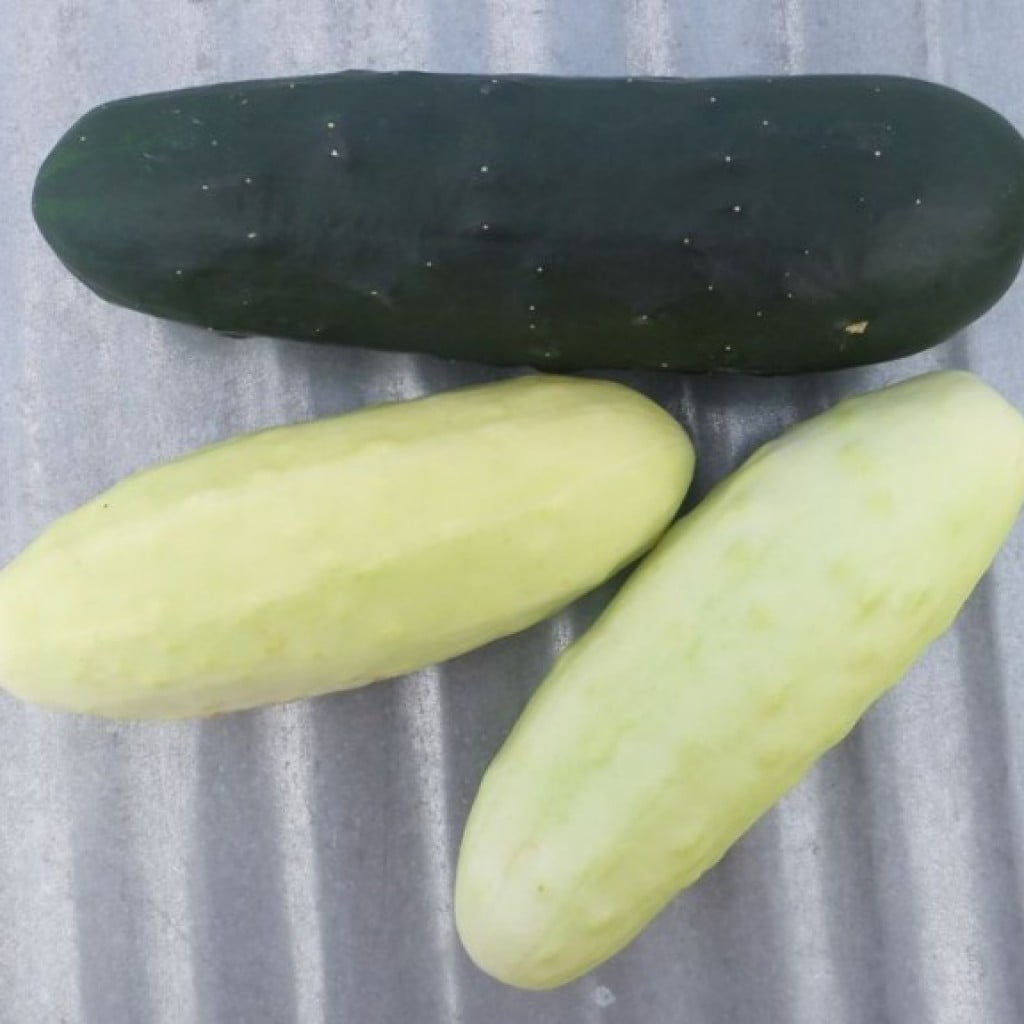
Slicing cucumber (green) and Silver Slicers cucumbers (white)
RECIPES
Visit our Recipe Log, a list of all our 2017 recipes to date.
LOCAL THYME RECIPES
Comforting Classics
.
Outside the Box Recipes
.
Quick and Easy Meal
RECIPES FROM LAUREN
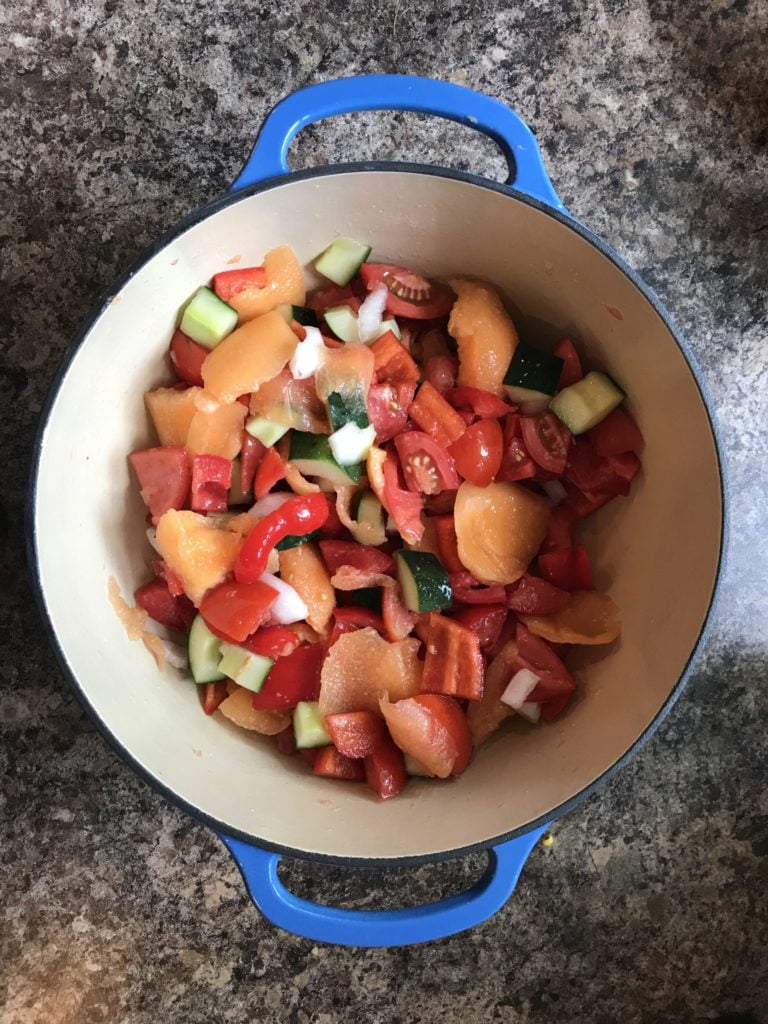
MUSKMELON GAZPACHO
I never thought I could like gazpacho. A cold soup of pureed veggies? It sounded absolutely terrible to me. Then I had gazpacho with melon. Beth and Steve remember this transformative moment. It was a watermelon gazpacho I made for a dinner we had together. It was sweet, savory, bright and flavorful. It wasn’t just pureed vegetables. It was wonderful. This muskmelon gazpacho is equally interesting and even more simple. This is the kind of dish you can throw together quickly after a long day and feel refreshed. This is summer eating at it’s finest. Hope you enjoy! Lauren.
Serves 4-6
Takes 50 minutes
1/2 head muskmelon, seeds removed
1 large cucumber, seeds removed
1 large red pepper, seeds removed
2 pounds extra ripe tomatoes, cored
1/2 Walla Walla onion
1 tablespoon salt
2 tablespoons sherry vinegar
3 tablespoons olive oil
-
- Roughly chop muskmelon (I just removed pieces with a spoon in odd shapes), cucumber, red pepper, tomatoes and onion. Place in a large bowl or stock pot along with salt and vinegar. Let sit for 30 minutes.
- Add olive oil and process until 90% smooth. You can do this several ways: blender, food processor, immersion blender. I mashed it with a potato masher first and then used an immersion blender.
- Taste and adjust seasonings. Serve at room temperature.
.
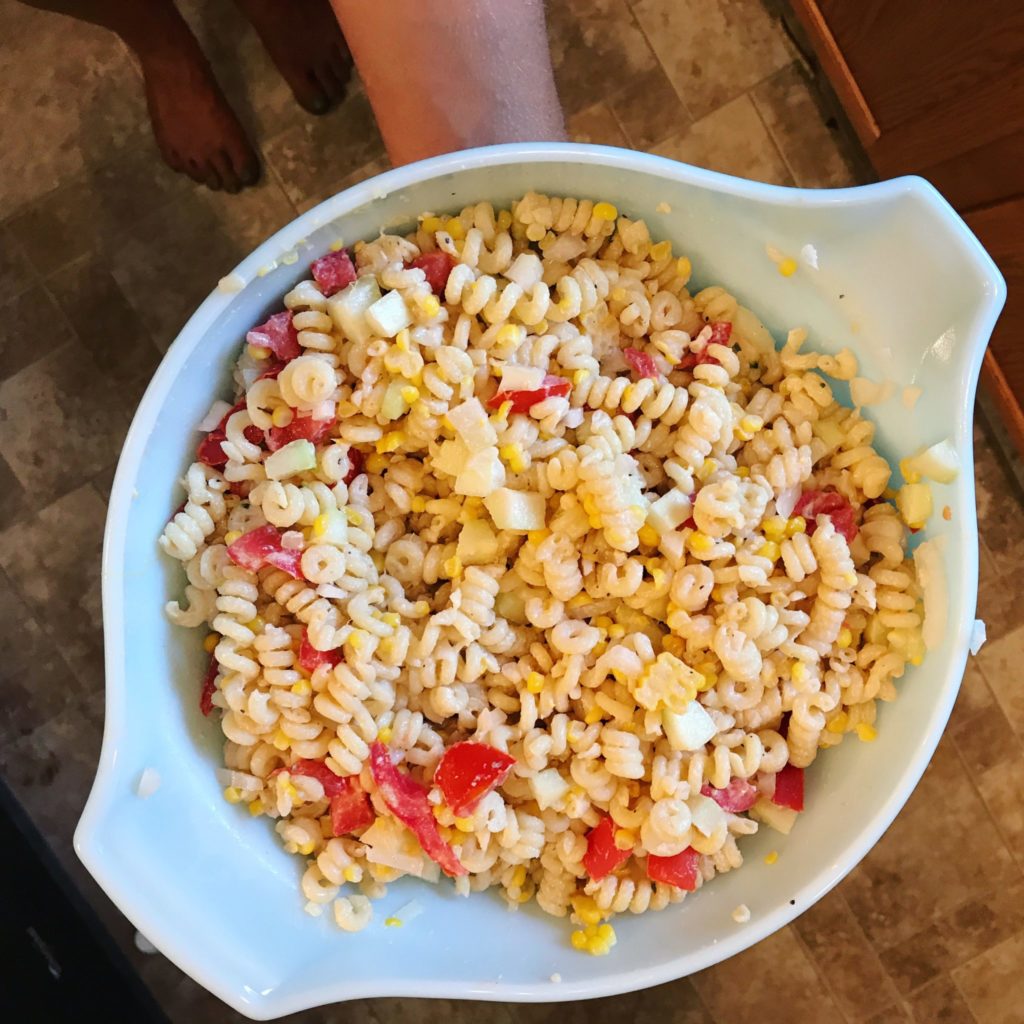
TOMATO & SWEET CORN PASTA SALAD
We have entered the land of peak summer produce. There are melons, peppers, tomatoes, cucumbers, sweet corn and so much more. The harvests are heavy and the eating is easy. With yummy summer veggies like this it’s important to just keep things simple. This pasta salad is as versatile as it is quick to make. I love the combination of tomatoes, sweet corn, cucumber, onion and basil, but you could easily add any cherry tomatoes, broccoli, or peppers you have laying around. Feel free to also use half the amount of noodles if you like more veggies than noodles in your pasta salad. Hint: a noodle with more nooks and crannies equals a better pasta salad. I love fusilli and orechiette. Lauren.
Serves 8-12 as a side
Takes 40 minutes
1 pound pasta
1 silver slicer
1/2 Walla Walla onion
1/2-1 pound tomato, seeded and roughly chopped
4 ears corn, husks removed
1/2 cup basil leaves, roughly chopped
Dressing:
1/4 cup mayo
1/4 cup Greek yogurt
1 tablespoon white wine or white vinegar
1 tablespoon kosher salt
1/2 tablespoon sugar
1/2 teaspoon freshly ground black pepper
-
- Bring a large pot of well-salted water to a boil on the stove over high heat. Once boiling, add pasta and cook to al dente according to package directions.
- While pasta cooks, prepare your dressing by whisking together all ingredients.
- Drain pasta in a colander and let sit for a minute to lose some of the water, then add to a large bowl. Add dressing to noodles while they’re still warm and toss to combine. Set aside.
- Refill stock pot with salted water and bring to a boil. Once boiling, add sweet corn and cook for 7 minutes. Meanwhile, chop your other veggies. Rinse corn under cold water to cool and then cut off kernels with a knife. Add cucumber, onion, tomatoes, corn and basil to bowl. Toss to combine.
- Taste and adjust salt and pepper as desired.




